Hisense Electric LCDF0005 Part15 Subpart B-LCD Monitor User Manual W9HLCDF0005 1
Hisense Electric Co., Ltd. Part15 Subpart B-LCD Monitor W9HLCDF0005 1
Contents
- 1. W9HLCDF0005_user Manual 1
- 2. W9HLCDF0005_user Manual 2
W9HLCDF0005_user Manual 1

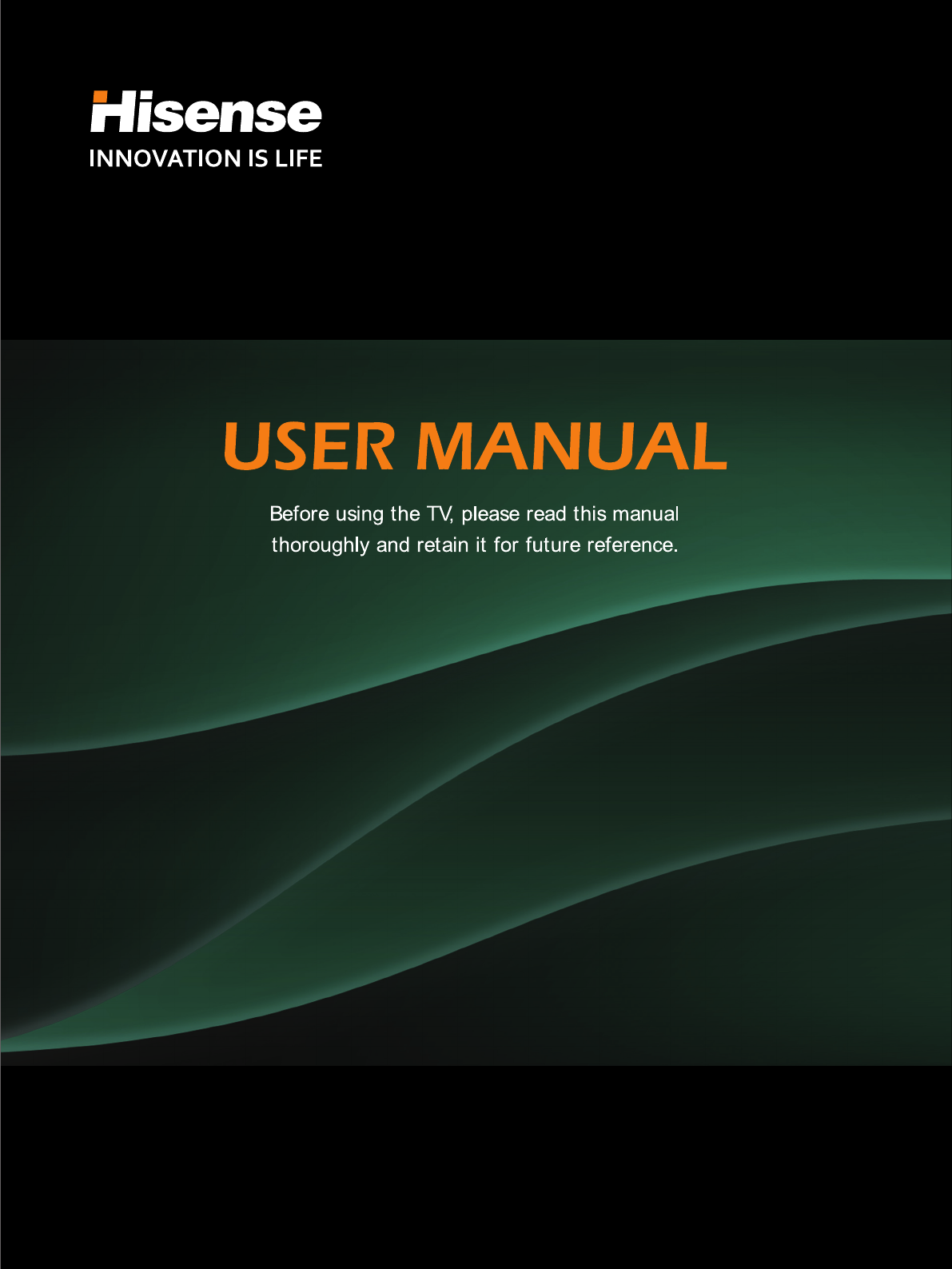
55T770DW
English
www.hisense-usa.com
service@hisense-usa.com
ES-G120902

I
The lightning flash with arrowhead symbol, within an
equilateral triangle is intended to alert the user to the
presence of uninsulated dangerous voltage within the
product's enclosure that may be of sufcient magnitude
to constitute a risk of electric shock.
The exclamation point within an equilateral triangle is
intended to alert the user to the presence of important
operating and maintenance (servicing) instructions in
the literature accompanying the appliance.
FCC Statement Energy Star
NOTE:
This equipment has been tested and found to comply with
the limits for a class B digital Device, pursuant to part 15
of the FCC Rules. These limits are designed to provide
reasonable protection against harmful interference in a
residential installation. This equipment generates, uses and
can radiate radio frequency energy and, if not installed and
used in accordance with the instructions, may cause harmful
interference to radio Communications. However, there is
no guarantee that interference will not occur in a particular
installation. If this equipment does cause harmful interference
to radio or television reception, which can be determined by
turning the equipment off and on, the user is encouraged to
try to correct the interference by one or more of the following
measures:
Reorient or relocate the receiving antenna.
Increase the separation between the equipment and the
receiver.
Connect the equipment into an outlet on a circuit different
from that to which the receiver is connected.
Consult the dealer or an experienced radio/TV technician
for help.
FCC ID Number WiFi Module: WWMMN421V1
Your Hisense TV is ENERGY STAR
qualified in the “Home” mode. It meets
strict energy efficiency guidelines set
by the U.S. Environmental Protection
Agency and Department of Energy.
ENERGY STAR is a joint program of
these government agencies, designed
to promote energy efficient products
and practices. Changes to certain features, settings, and
functionalities of this TV (i.e. TV Guide, Picture, Sound) can
increase or change the power consumption. Depending upon
such changed settings, the power consumption may exceed
the limits required for the ENERGY STAR qualification in the
“Home” mode.
WARNING
The manufacturer is not responsible for any radio or TV
interference caused by unauthorized modifications to
this equipment. Such modifications could void the user's
authority.
NOTE
Where the MAINS plug or an appliance coupler is used
as the disconnect device, the disconnect device shall
remain readily operable.
Hisense and associated logos where applicable are registered trademarks of Hisense Group in the United States and/or other
countries. All other trademarks are property of their respective owners. 2011 Hisense USA, Corporation. All Rights Reserved.
Manufactured under license from Dolby Laboratories. Dolby and the double-D symbol are trademarks of Dolby Laboratories.
* Specications subject to change without notice. All other trademarks, logos and copyrights are the property of their respective
owners.
This TV incorporates High-Denition Multimedia Interface (HDMITM) technology.
HDMI, the HDMI logo and High-Denition Multimedia Interface are trademarks or registered trademarks of HDMI Licensing LLC.
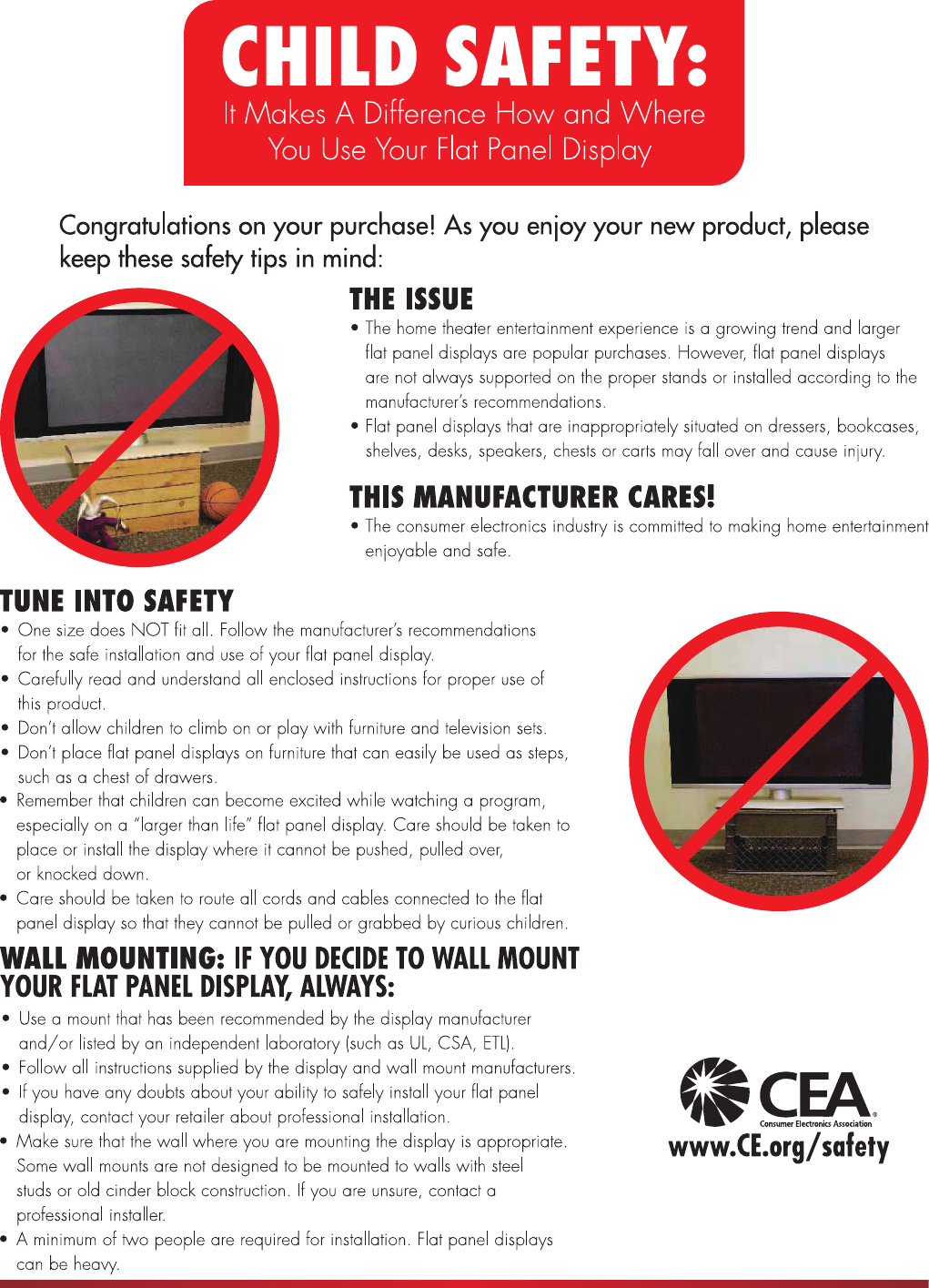
II
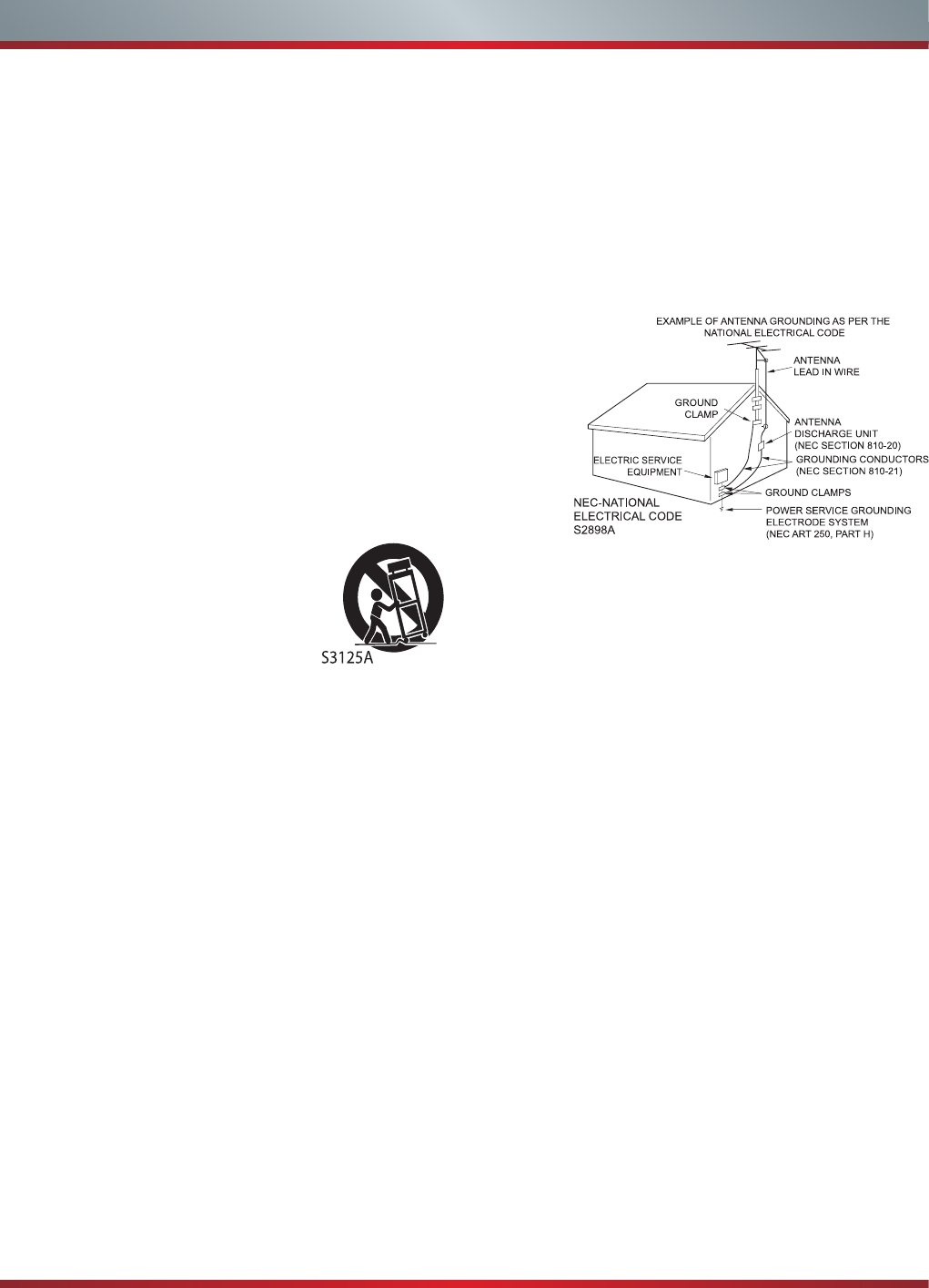
III
Important Safety Instructions
1. Read these instructions.
2. Keep these instructions.
3. Heed all warnings.
4. Follow all instructions.
5. Do not use this apparatus near water.
6. Clean only with dry cloth.
7. Do not block any ventilation openings. Install in accordance
with the manufacturer's instructions.
8. Do not install near any heat sources such as radiators,
heat registers, stoves, or other apparatus (including
amplifiers) that produce heat.
9. Do not defeat the safety purpose of the polarized or
grounding-type plug. A polarized plug has two blades with
one wider than the other. A grounding type plug has two
blades and a third grounding prong. The wide blade or the
third prong are provided for your safety. If the provided
plug does not fit into your outlet, consult an electrician for
replacement of the obsolete outlet.
10. Protect the power cord from being walked on or pinched
particularly at plugs, convenience receptacles, and the
point where they exit from the apparatus.
11. Only use attachments/accessories
specified by the manufacturer.
12. Use only with cart, stand, tripod,
bracket, or table specified by the
manufacturer, or sold with the
apparatus. When a cart is used,
use caution when moving the cart/
apparatus combination to avoid injury from tip-over.
13. Unplug this apparatus during lightning storms or when
unused for long periods of time.
14. Refer all servicing to qualified service personnel.
Servicing is required when the apparatus has been
damaged in any way, such as power-supply cord or plug
is damaged, liquid has been spilled or objects have fallen
into the apparatus, the apparatus has been exposed to
rain or moisture, does not operate normally, or has been
dropped.
15. Apparatus should not be exposed to dripping or
splashing, and objects filled with liquids, such as vases,
should not be placed on the apparatus.
16. An outside antenna system should not be located in the
vicinity of overhead power lines or other electric light or
power circuits, or where it can fall into such power lines
or circuits. When installing an outside antenna system,
extreme care should be taken to keep from touching
such power lines or circuits, as contact with them might
be fatal.
17. Do not overload wall outlets and extension cords, as this
can result in a risk of fire or electric shock.
18. Do not push objects through any openings in this unit,
as they may touch dangerous voltage points or short out
parts that could result in fire or electric shock. Never spill
or spray any type of liquid into the unit.
19. If an outside antenna or cable system is connected to the
unit, be sure the antenna or cable system is grounded to
provide some protection against voltage surges and built-
up static charges, Section 810 of the National Electrical
Code, ANSI/NFPA 70, provides information with respect
to proper grounding of the mast and supporting structure,
grounding of the lead-in wire to an antenna discharge
unit, size of grounding conductors, location of antenna
discharge unit, connection to grounding electrodes, and
requirements for the grounding electrode.
20. When replacement parts are required, be sure the service
technician uses replacement parts specified by the
manufacturer or those that have the same characteristics
as the original part. Unauthorized substitutions may result
in fire, electric shock or other hazards.
21. Upon completion of any service or repairs to this unit,
ask the service technician to perform safety checks to
determine that the unit is in proper operating condition.
22. When you connect the product to other equipment, turn
off the power and unplug all of the equipment from the
wall outlet. Failure to do so may cause an electric shock
and serious personal injury. Read the owner's manual of
the other equipment carefully and follow the instructions
when making any connections.
23. Sudden high volume sound may cause hearing or
speaker damage. When you use headphones, (if the unit
is equipped with a headphone jack) keep the volume at a
moderate level. If you use headphones continuously with
high volume sound, it may cause hearing damage.
CONDENSATION:
Moisture will form in the operating section of the unit if the
unit is brought from cool surroundings into a warm room or
if the temperature of the room rises suddenly. When this
happens, unit's performance will be impaired. To prevent
this, let the unit stand in its new surroundings for about an
hour before switching it on, or make sure that the room
temperature rises gradually.
Condensation may also form during the summer if the unit is
exposed to the breeze from an air conditioner. In such cases,
change the location of the unit.

IV
Important Safety Instructions
HOW TO HANDLE THE LCD PANEL:
Do not press hard or jolt the LCD panel. It may cause the
LCD panel glass to break and injury may occur.
If the LCD panel is broken, make absolutely sure that you
do not touch the liquid in the panel. This may cause skin
inflammation.
If the liquid gets in your mouth, immediately gargle and
consult with your doctor. Also, if the liquid gets in your eyes
or touches your skin, consult with your doctor after rinsing
for at least 15 minutes or longer in clean water.
Possible Adverse Effects on LCD Panel:
If a fixed (non-moving) pattern remains on the LCD Panel
for long periods of time, the image can become permanently
engrained in the LCD Panel and cause subtle but permanent
ghost images. This type of damage is NOT COVERED BY
YOUR WARRANTY. Never leave your LCD Panel on for long
periods of time while it is displaying the following formats or
images:
Fixed Images, such as stock tickers, video game patterns,
TV station logos, and websites.
Special Formats that do not use the entire screen. For
example, viewing letterbox style (16:9) media on a normal
(4:3) display (black bars at top and bottom of screen); or
viewing normal style (4:3) media on a widescreen (16:9)
display (black bars on left and right sides of screen).
The following symptoms are not signs of malfunction
but technical limitation. Therefore we disclaim any
responsibility for these symptoms.
LCD Panels are manufactured using an extremely high
level of precision technology, however sometimes parts
of the screen may be missing picture elements or have
luminous spots.
This is not a sign of a malfunction.
Do not install the LCD Panel near electronic equipment that
produces electromagnetic waves. Some equipment placed
too near this unit may cause interference.
Effect on infrared devices - There may be interference
while using infrared devices such as infrared cordless
headphones.
Declaration of Conformity
This device complies with part 15 of the FCC Rules.
Operation is subject to the following two conditions:
(1) This device may not cause harmful interference and (2)
This device must accept any interference received, including
interference that may cause undesired operation.
Your TV also contains material that can be recycled and
reused. For disposal or recycling information, contact your
local authorities or the Electronic Industries Alliance at
www.eia.org to find a recycler in your area.
The LCD panel contains almost 3 million thin film transistors,
which provide exceptionally sharp video quality. Occasionally,
a few non-active pixels may appear on the screen as a
fixed black (in the case of a dead pixel), blue, green, or red
point. These non-active pixels do not adversely affect the
performance of your TV, and are not considered defects.
TO USE AC POWER
1. The power cord is attached to the TV at the factory.
2. Connect the AC cord into an AC outlet.
End of life directives
Non-active pixels
Power source
WARNING
Do not connect this unit to the power using any device
other than the supplied AC cord. This could cause fire,
electrical shock, or damage.
Do not use with a voltage other than the power voltage
specified. This could cause fire, electrical shock, or
damage.
CAUTION
When this unit is not used for a long time, (e.g., away on
a trip) in the interest of safety, be sure to unplug it from
the AC outlet.
Do not plug/unplug the AC cord when your hands are
wet. This may cause electrical shock.

V
Important Safety Instructions
Disclaimer: Hisense USA companies ("Hisense"). A wired
or wireless Internet connection is required for certain features
and is not included with the television; please contact a
local Internet Service Provider for assistance. Content
suppliers may require a subscription to activate or use their
services which is not included with the television and is sold
separately. The Hisense TV web browser supports a variety
of multimedia platforms however it does not support all
players nor does it support every player version, therefore,
access to certain web content may be limited or unavailable.
INTERNET CONNECTION, ACCEPTANCE OF END USER
LICENSE AGREEMENT (EULA) AND REGISTRATION
OF YOUR HISENSE TELEVISION SERIAL NUMBER IS
REQUIRED. YOU MUST BE AT LEAST 13 YEARS OF AGE
TO REGISTER ONLINE. HISENSE MAY ADD, DELETE,
MODIFY, OR TERMINATE ONLINE SERVICES WITHOUT
NOTICE.
Consent to Use of Data: To facilitate the provision of
software updates, any dynamically served content, product
support and other services you agree that Hisense and its
affiliates may collect, use, store and transmit technical and
related information that identifies your television (including an
Internet Protocol Address), its operating system, application
software and any connected devices. Hisense and its
affiliates may also use this information in the aggregate, in
a form which does not personally identify you, to improve
our products and services and we may share anonymous
aggregate data with our third party service providers.
Internet Performance Issues: A broadband Internet
connection is required for access to Internet Apps and
Content. To avoid poor performance while accessing Internet
Apps and Content, be sure other devices on the same
Internet connection are not running file sharing applications,
streaming audio or video content and are not logged in
to chat-rooms. These applications may consume your
connection’s bandwidth, causing lag or other undesirable
effects. This television uses TCP and UDP port(s) to access
Internet Apps and Content. Please consult your router or
personal firewall documentation for information on how to
allow access to these ports. If you are installing this television
on a corporate Internet connection, contact your network
administrator for information and assistance.
Liability: The Hi-Smart portal may be linked to other
sites on the World Wide Web or Internet which are not
under the control of or maintained by Hisense. Such
links do not constitute an endorsement by Hisense. You
acknowledge that Hisense is providing these links to you
only as a convenience; you further agree that Hisense is not
responsible for the content of such sites.
INFORMATION ACCESSED OR OBTAINED VIA Hi-
Smart IS PROVIDED "AS IS" WITHOUT WARRANTY
OF ANY KIND, EITHER EXPRESS OR IMPLIED,
INCLUDING BUT NOT LIMITED TO, THE IMPLIED
WARRANTIES OF MERCHANTABILITY, FITNESS FOR
A PARTICULAR PURPOSE, OF NON INFRINGEMENT.
SOME JURISDICTIONS DO NOT ALLOW FOR THE
EXCLUSION OF IMPLIED WARRANTIES, SO THE ABOVE
EXCLUSIONS MAY NOT APPLY TO YOU.
Access to certain areas of the Hi-Smart portal is restricted
and requires a password for entry. If you are an authorized
password holder, you agree that you are entirely responsible
for the confidentiality of your password and account
information, and agree to notify Hisense immediately if your
password is lost, stolen, disclosed to an unauthorized third
party, or other wise may have been compromised. You agree
that you are entirely responsible for any and all activities
which occur under your account, including any fees which
may be incurred under your password protected account
whether or not you are the individual who undertakes such
activities. You agree to immediately notify Hisense of any
unauthorized use of your account or any other breach of
security in relation thereof known to you.
You acknowledge that Hi-Smart may include certain
inaccuracies or typographical errors which may affect the
quality of materials and third-party content. You acknowledge
that the materials or any third-party content have not been
independently verified or authenticated in whole or in part
by Hisense, and agree that Hisense does not warrant the
accuracy or timeliness of materials or the third-party content,
and further agree that Hisense has no liability for any
omissions in the materials and content, whether provided by
Hisense or any third-party.
To the maximum extent permitted by applicable law, Hisense
shall not be liable to you or a third-party claiming through
you for any damage suffered as a result of your displaying,
copying or downloading information or material accessed or
obtained via Hi-Smart. In no event shall Hisense be liable
to you or any third-party for any indirect, extraordinary,
exemplary, punitive, special incidental or consequential
damages (including loss of data, revenue, profits or other
economic advantage) however arising, whether for breach
or in tort even if HISENSE has previously advised of the
possibility of such possible damage.
Technical Support: If you have questions regarding
installation, configuration or operation of this product, please
telephone a Hisense Customer Care representative who
will be happy to assist you with any difficulties you may be
experiencing.
Dial: 1-888-935-8880 (Toll Free)
Email: service@hisense-usa.com

1
Contents
Getting Started
Accessories List...............................................................................................3
Installing the Stand .......................................................................................... 3
Installing a Wall-Mount Bracket .......................................................................4
When Installing the TV Against a Wall or Enclosed Area ................................ 5
Viewing the Control Panel ...............................................................................6
Viewing the Remote Control ............................................................................7
Installing Batteries in the Remote Control .......................................................8
Match the Remote Control with TV ..................................................................8
Making Connections ........................................................................................ 9
Basic Features
Turning the TV on or off ..................................................................................13
Turning the TV On for the First Time ..............................................................13
Selecting the Input Source .............................................................................13
Changing Channels / Volume ......................................................................... 14
Shortcuts Instructions ..................................................................................... 14
To Use the Menu ............................................................................................15
Using the Picture Menu ..................................................................................15
Using the Audio Menu .................................................................................... 16
Using the Screen Menu .................................................................................. 17
Using the Channels Menu ..............................................................................17
Using the Settings Menu ................................................................................18
Using the Lock Menu ......................................................................................19
Advanced Features
Network Connection .......................................................................................20
DLNA Settings ................................................................................................ 23
Media Share Settings in Computer.................................................................24
Settings to Share Files ...................................................................................24

2
Contents
Advanced Features
Network Function............................................................................................25
Enter the Network Applications....................................................................... 26
VUDU HD Movies ...........................................................................................27
VUDU Apps ....................................................................................................28
Netix..............................................................................................................28
Opera..............................................................................................................29
YouTube .........................................................................................................31
Other Apps......................................................................................................32
Other Information............................................................................................33
Digital Media Play ...........................................................................................34
Enjoy Video Files ............................................................................................ 34
Enjoy Music Files............................................................................................35
Browse the Pictures........................................................................................35
Browse the Text Files .....................................................................................36
Other Information
Trouble Shooting ............................................................................................37
General ...........................................................................................................39
Illustrations are for your reference only!
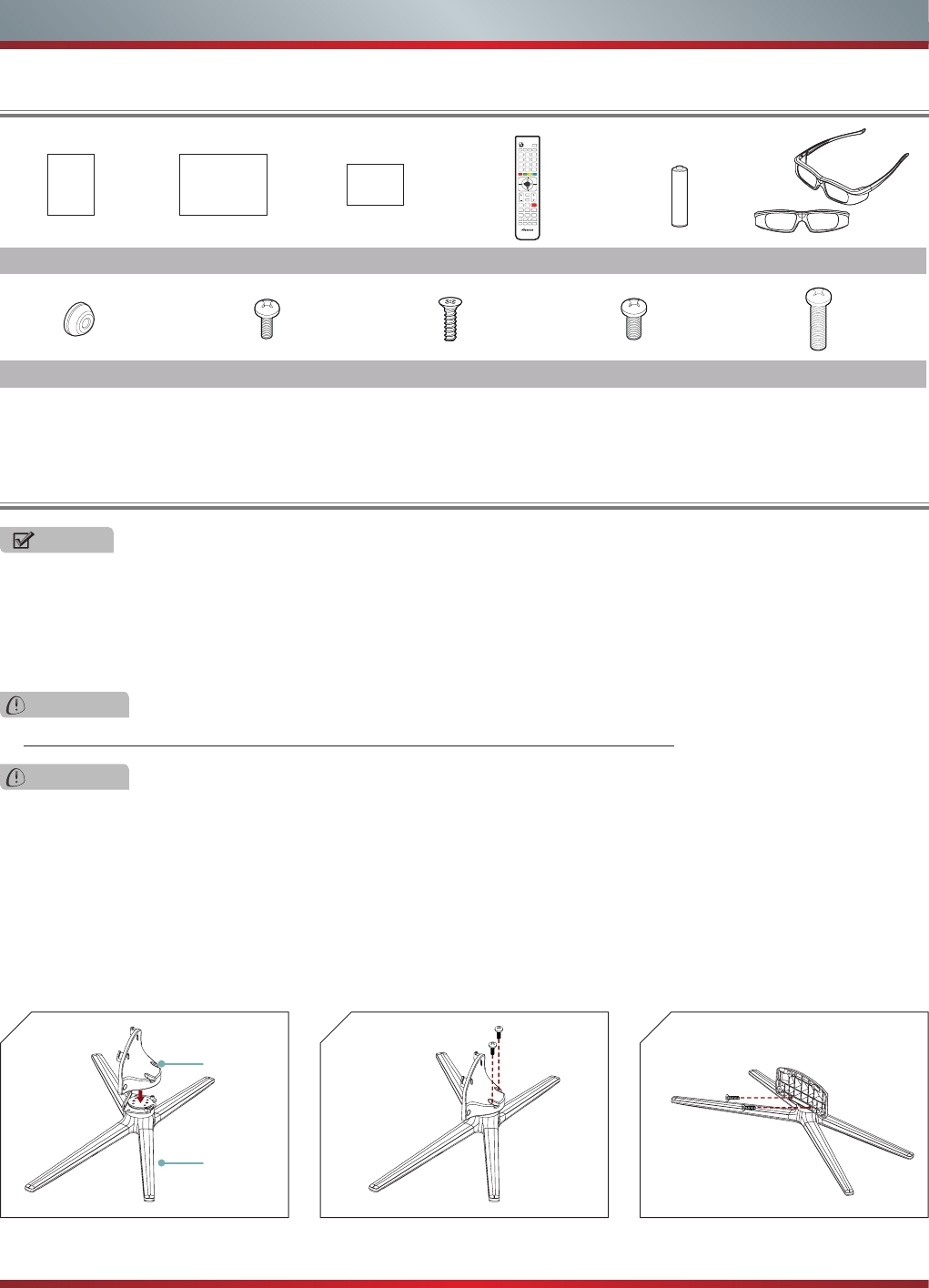
3
Getting Started
Accessories List
Installing the Stand
USER MANUAL Quick Setup Guide Warranty Card
User Manual Quick Setup Guide Warranty Card Remote Control Battery × 2 3D Glasses × 2
NOTES
1. The LCD display is very fragile, and must be protected at all times when removing the base stand. Be sure that no hard or
sharp object, or anything that could scratch or damage the LCD display, comes into contact with it. DO NOT exert pressure
on the front of the TV at any time because the screen could crack.
2. For tabletop use, the TV must be attached to the provided stand as shown on this page.
3. To Wall-Mount, brackets (not provided) must be attached to the TV as shown on next page.
Follow the illustrations below to complete the installation steps:
1. Align the stand cover with the X-shaped stand as shown in Figure 1.
2. Secure the stand cover to the X-shaped stand vertically with the two provided Screws A. See Figure 2.
3. Secure the stand cover to the X-shaped stand horizontally with the two provided Screws B. See Figure 3.
WARNING
Be sure to disconnect the AC power cord before installing a stand or Wall-Mount brackets.
CAUTION
Use a covered table or bench to lay the TV on and handle the TV carefully to prevent damage to the TV screen or cabinet
during assembly.
3
ScrewB (ST4×L14)
2
ScrewA (M4 × L12)
1
Stand Cover
X-shaped
Stand
Spacer×4 Screws: ScrewA (M4×L12)×2 ScrewB (ST4×L14)×2 ScrewC (M5×L12)×4 ScrewD (M6×L25)×4
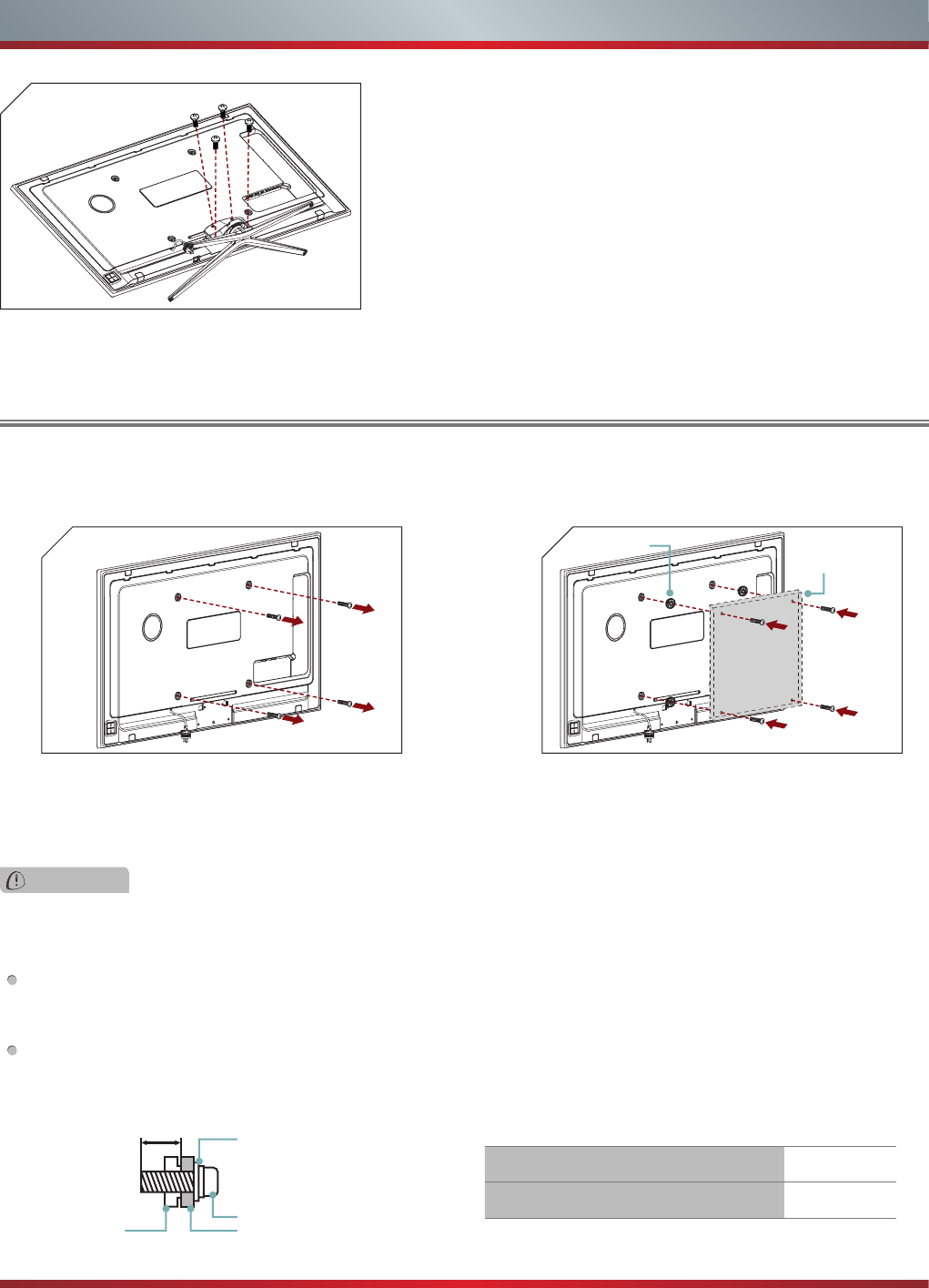
4
Getting Started
4
ScrewC (M5 × L12)
4. Carefully place your TV on a soft, cushioned, surface to
prevent damage to the screen.
Align the stand cover with the screw holes on the bottom
of TV back, secure the stand to the TV with the four
provided Screws C. See Figure 4.
Installing a Wall-Mount Bracket
If you want to attach the TV to a Wall-Mount bracket (not provided), you should first remove the stand if it is pre-attached (see
Step 1).
1. Make sure the TV is laid face-down on a clean, safe,
and cushioned space, remove the original screws in the
bracket holes on the TV back over.
3. Follow instructions provided with the Wall-Mount bracket.
If you are not sure of your ability to do complete the installation, contact a professional installer or service technician for
assistance. The manufacturer is not responsible for any damages or injuries that occur due to mishandling or incorrect
assembly.
The selected screws are 6.5 ~ 7.5 mm in length when measured from the attaching surface of the TV's rear cover. The
diameter and length of the screws differ depending on the Wall-Mount Bracket model.
2. Place the provided spacers in the corresponding bracket
holes. Attach purchased bracket (1.5 ~ 2.5 mm thickness)
on the TV with 4 screws (M6 × L25) which in accessories
bag. Follow instructions provided with the wall bracket.
1
WARNING
Use only the 4 screws (M6 × L25) provided with the TV to prevent internal damage to the TV set or cause it to fall.
Wall-Mount Bracket
6.5 ~ 7.5 mm
Screw
Spacerthe TV's rear cover
Wall-Mount hole pattern VESA (mm) 400 × 400
Wall-Mount screw size (mm) M6
ScrewD (M6 × L25)
2Spacer × 4 Bracket
(1.5~2.5mm)
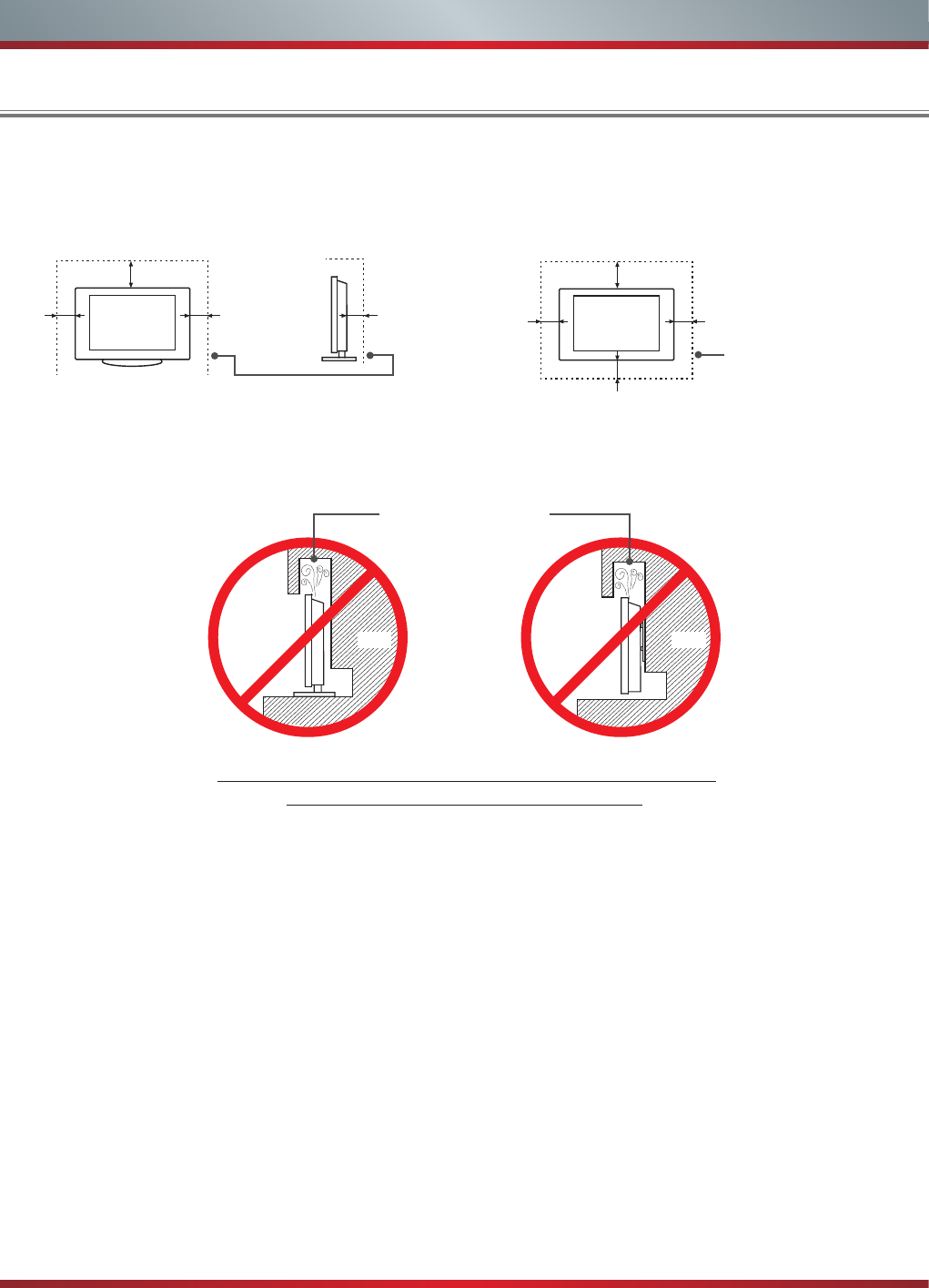
5
Getting Started
When Installing the TV Against a Wall or Enclosed Area
Install with stand
Never install the TV set as follows:
Install on the wall
Make sure that your TV has adequate air circulation. Allow enough space around the TV as shown below. Avoid operating the
TV at temperatures below Inadequate air 41°F (5°C).
Leave at least this much
space around the set.
Leave at least this much
space around the set.
4 inches
(10cm)
4 inches
(10cm) 4 inches
(10cm)
4 inches
(10cm)
4 inches
(10cm)
2 3⁄8 inches
(6cm)
12 inches
(30cm) 12 inches
(30cm)
Wall Wall
Air circulation is blocked.
Inadequate air circulation can lead to overheating of the TV and
may cause damage to your TV or cause a re.
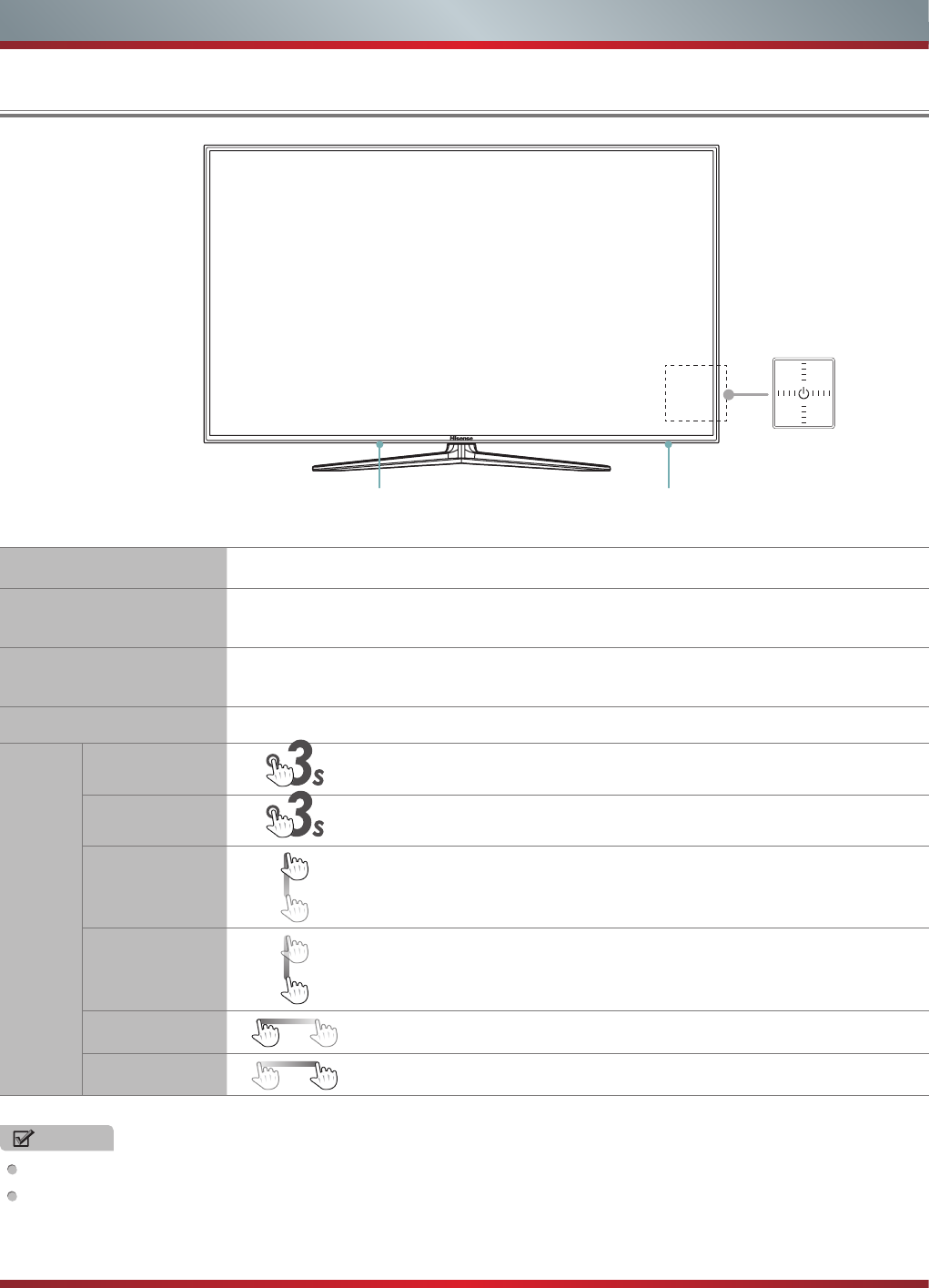
6
Viewing the Control Panel
Getting Started
Remote sensor
3D emitter
Power indicator
Tap Pad
(On the TV Rear)
Item Description
Remote sensor Receives remote signals from the remote control.
Do not put anything near the sensor, as its function may be affected.
3D emitter Sends signals to 3D glasses during playback of 3D movies and TV shows. Do not put
anything near the sensor, as its function may be affected.
Power indicator Light up in standby mode.
Tap
Pad
Turn On
(When TV off ) Press and hold 3 seconds for Power on.
Turn Off
(When TV on ) Press and hold 3 seconds for Power off.
CH
V
Slide up for Channel up.
CH V Slide down for Channel down.
VOL -Slide left (rear view) for Volume down.
VOL + Slide right (rear view) for Volume up.
NOTES
FOR ILLUSTRATION ONLY.
Powering up or down the TV requires several seconds of processing time. Do not rapidly turn the TV on/off as abnormal
operation may occur.
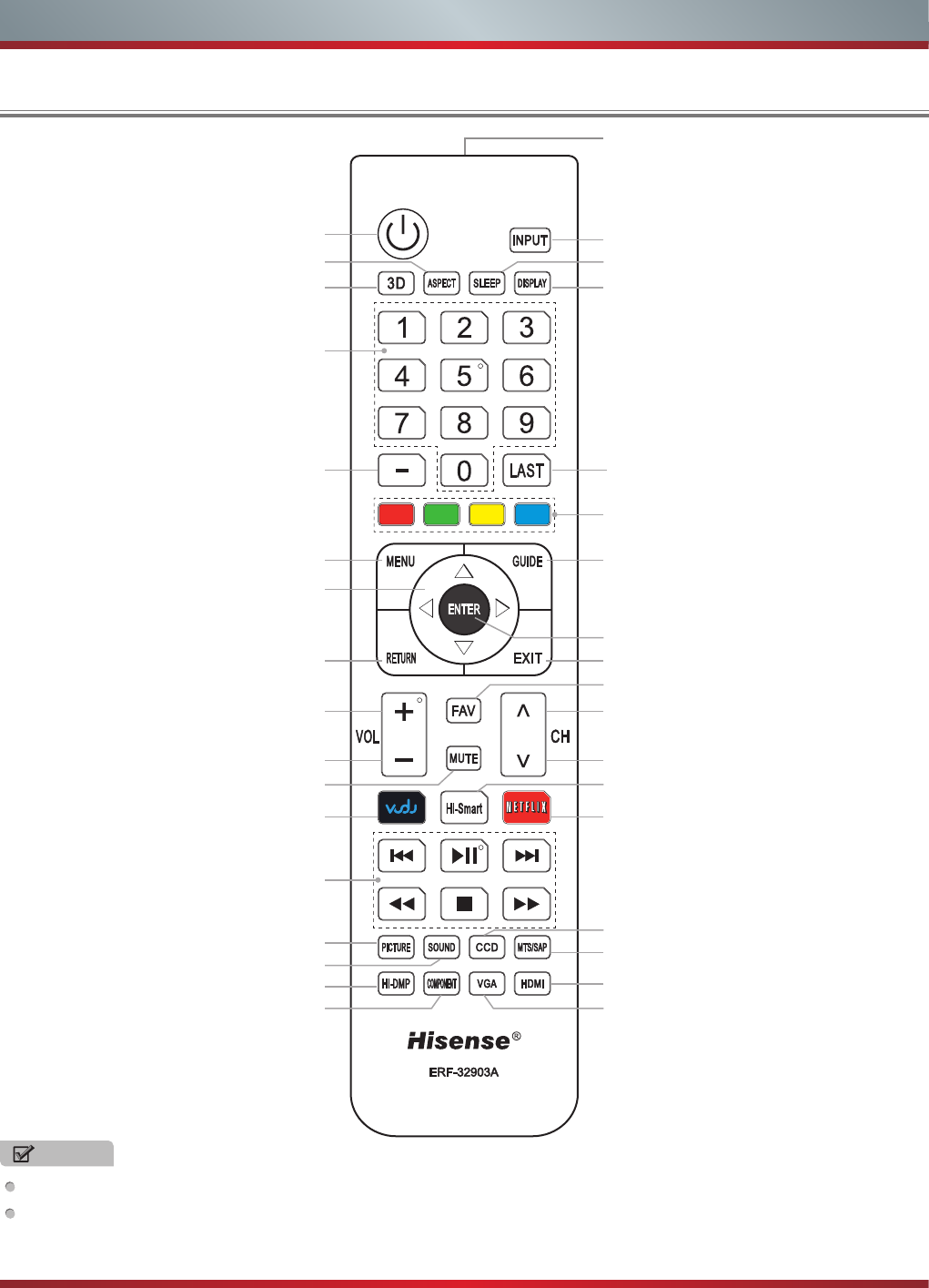
7
Viewing the Remote Control
Getting Started
NOTES
FOR ILLUSTRATION ONLY.
[RED/GREEN/YELLOW/BLUE] buttons are used for Electronic Program Guide (EPG), Hi-Smart Hub and Digital Media Player
(DMP). After pressing the [GUIDE], [Hi-Smart] or [Hi-DMP] button, the same color buttons will appear with explanations in the
on-screen display (OSD). Follow the steps shown in the OSD.
Power on/off
Increase Volume
Select sound mode
Decrease Volume
Launch Vudu Movies App
Return to the previous menu
Launch Netix App
Select picture mode
Menu button
Dash button
(use when entering a digital sub-channel
and when match the remote control with TV)
▲/
▲
/
▲
/
▲
Navigate Up/Down/Left/Right or
adjust on-screen menu settings
Displays the information banner
Sleep timer button
Select HDMI input source
Select VGA input source
Open the Hi-Smart Hub
Open the DTV program guide
(if available)
Hi-DMP (digital multimedia player) button
3D button
Display the favorite channel list
Conrm selections
Audio Mute button
Close the menu
Channel Up
Channel Down
Go to the previous channel and
use when match the remote control with TV
Select input source
Adjust Closed Caption Decoder (CCD) mode
Audio select button
Remote sensor
Select COMPONENT input source
Zoom button
Direct channel selection
Special function buttons
Media content control function buttons
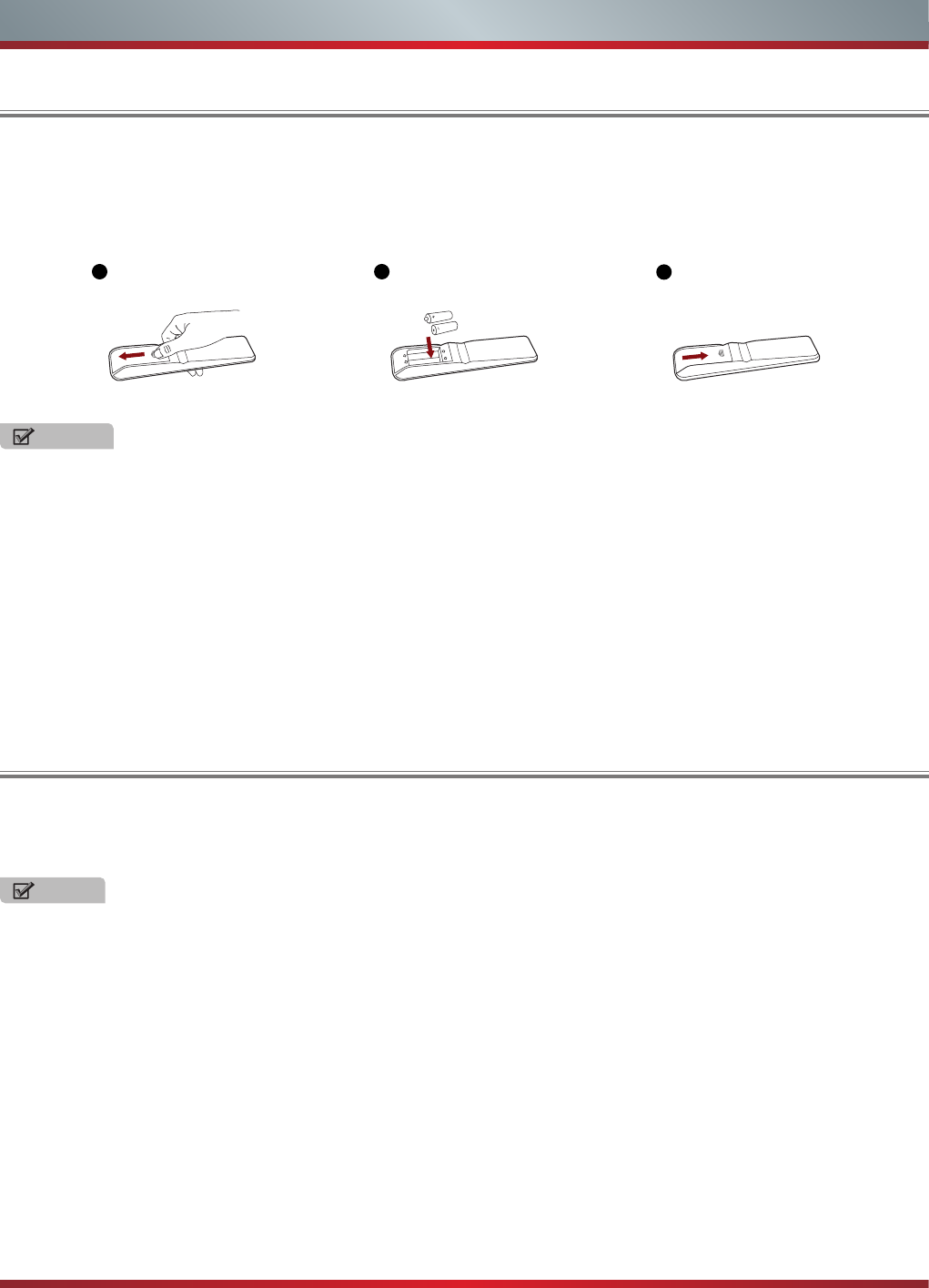
8
Installing Batteries in the Remote Control
Match the Remote Control with TV
Getting Started
NOTE
If the LED blinks rapidly, the remote has failed to pair with the TV, repeat the pairing procedure.
1. Slide the back cover to open the battery compartment of the remote control.
2. Insert two AAA size batteries. Make sure to match the (+) and ( - ) ends of the batteries with the (+) and ( - ) ends indicated in
the battery compartment.
3. Close the battery compartment cover.
Aim your remote control within 6 inches of the lower left corner of your TV. Press the [-] and [LAST] buttons simultaneously
for at least 3 seconds. The LED at the top of your remote will light for one second and blink slowly three times to indicated the
remote has paired with the TV.
1Gently push and slide 2Insert the batteries 3Gently push and slide
NOTES
1. Dispose of your batteries in a designated disposal area. Do not throw the batteries into a fire.
2. Do not mix battery types or combine used batteries with new ones.
3. Remove depleted batteries immediately to prevent battery acid from leaking into the battery compartment.
4. If you do not intend to use the remote control for a long time, remove the batteries.
5. Batteries should not be exposed to excessive heat, such as sunshine, heat registers, or fire.
6. Battery chemicals can cause a rash. If the batteries leak, clean the battery compartment with a cloth. If chemicals touch your
skin, wash immediately.
7. Do not mix old and new batteries.
8. Do not mix alkaline, standard (carbon-zinc) or rechargeable (ni-cad, ni-mh, etc.) batteries.
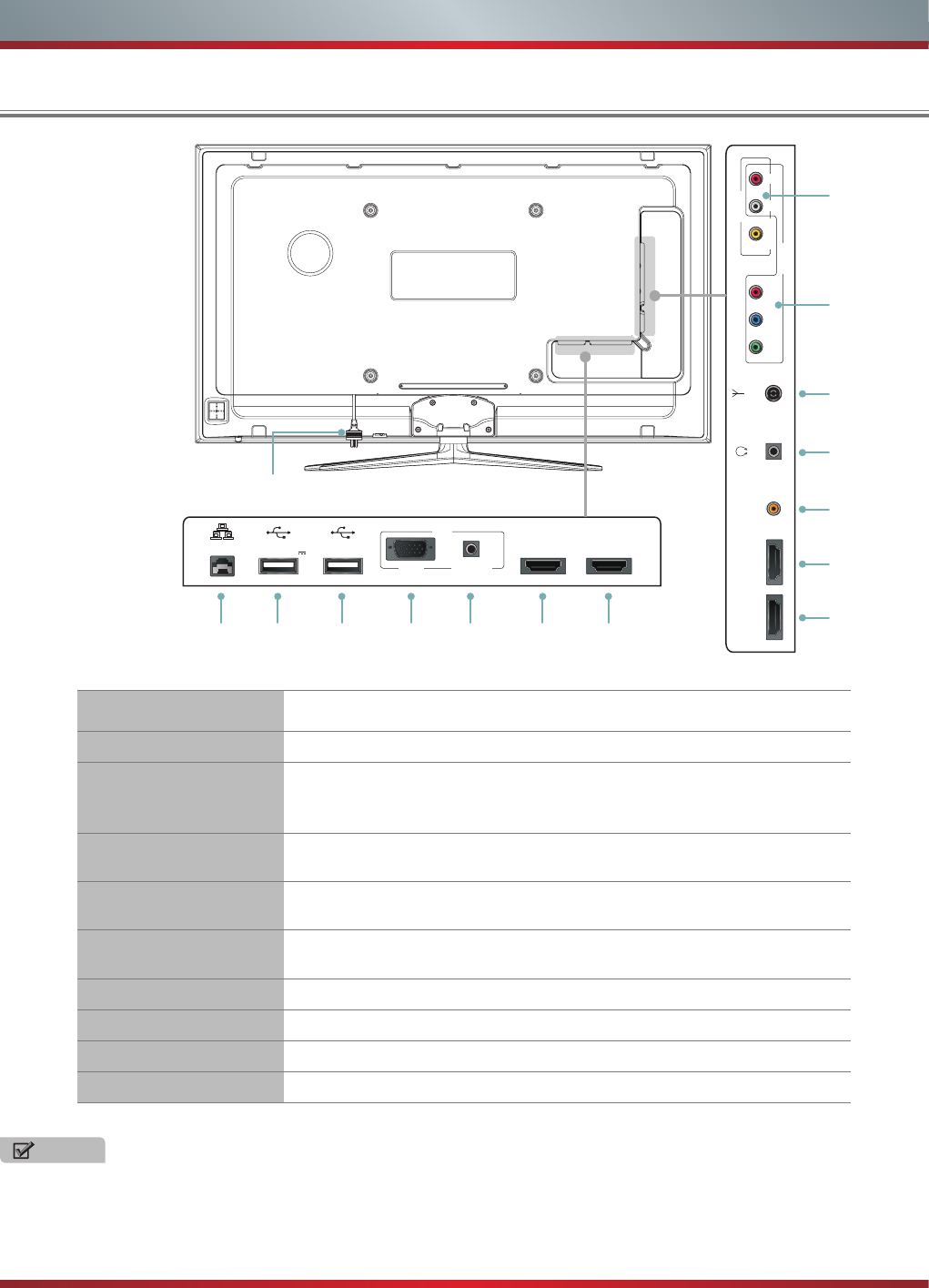
9
HDMI2 HDMI1 DIGITAL
AUDIO OUT
ANT/CABLE
IN
HEADPHONE
Y PBPRVIDEO
AV IN
COMP
L R
USB2
DC5V 0.5A(MAX)
USB1
LAN
VGA
PC
PC/DVI
AUDIO IN
HDMI4 HDMI3
Making Connections
Getting Started
Power input
LAN USB USB VGA HDMI HDMI
AV
HEADPHONE
ANT/CABLE
COMPONENT
HDMI
HDMI
DIGITAL
AUDIO OUT
PC/DVI
AUDIO IN
Item Description
ANT/CABLE Connect an antenna or cable TV to this jack.
HDMI
HDMI (High-Definition Multimedia Interface)provides an uncompressed,
all digital audio/video interface between this TV and any HDMI-device,
such as a set-top box, Blu-ray disc player, or A/V receiver.
COMPONENT Connect to a DVD player, Digital Set-Top-Box, or other A/V devices with
component (YPBPR) video and audio output jacks.
VIDEO/AUDIO(L,R) Connect to the composite video and audio (L/R) output jacks on external
video devices.
VGA
PC/DVI AUDIO IN Connect to a PC or other devices with a VGA interface.
HEADPHONE Connect headphone for private listening.
DIGITAL AUDIO OUT Connect to an external digital audio device.
USB Port for Digital Media Player and for charging 3D glasses.
LAN Connect an ethernet cable to access a network or the Internet.
NOTE
Some external devices impossible insert to this set for individual difference. Please replace with appropriate external signal
cable or increase the adapter to match with the port in such case.
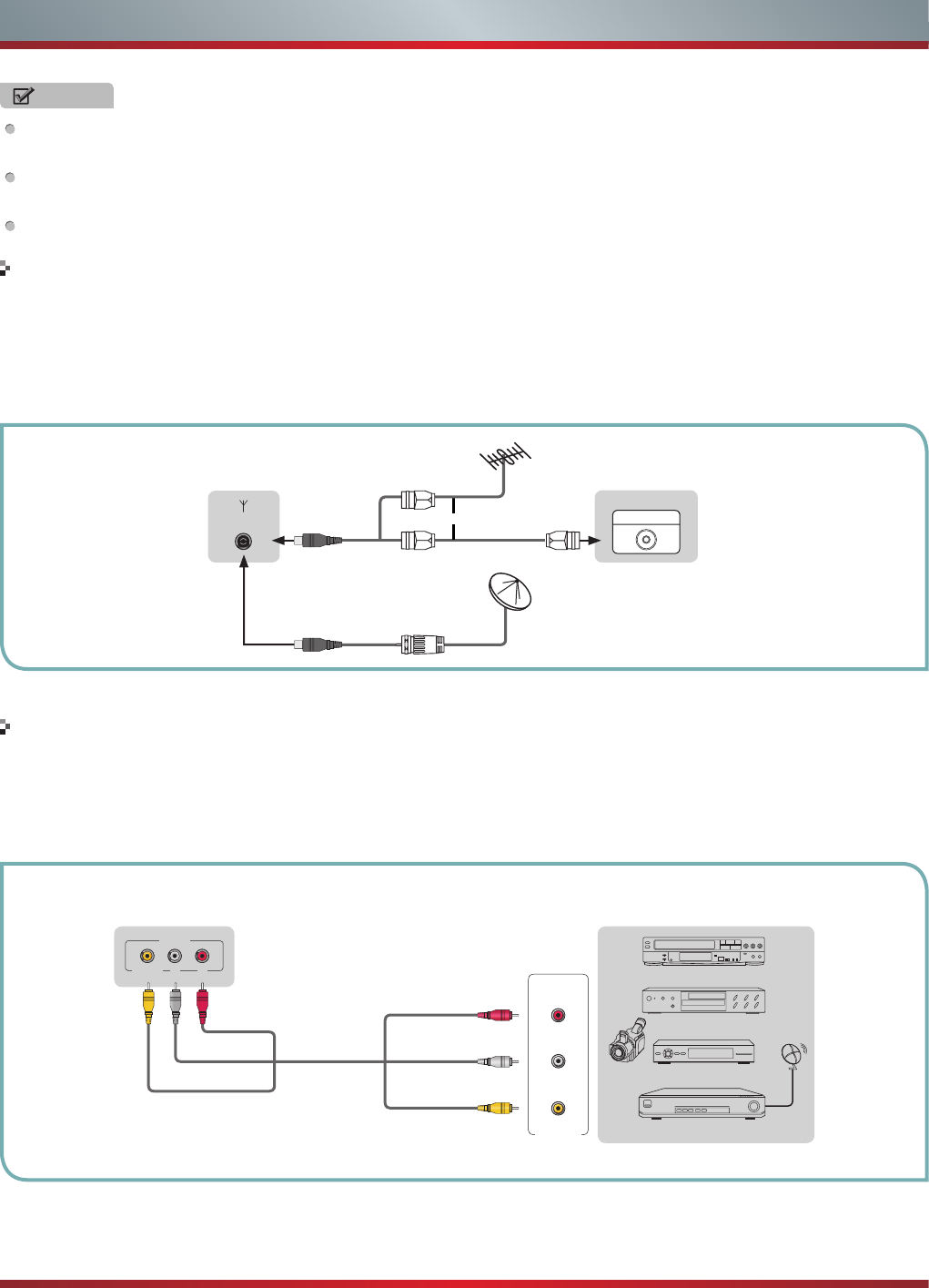
10
Getting Started
NOTES
Check the jacks for position and type before making any connections. Loose connections can result in image or color
problems. Make sure that all connections are tight and secure.
Not all A/V devices have the ability to connect to a TV, please refer to the user’s manual of your A/V device for compatibility
and connections procedure.
Always unplug the power cord when connecting external equipment.
Connecting an antenna, cable or cable/satellite box
Connecting an A/V Device with Composite Cable
or ANT OUT
Cable
VHF/UHF Antenna
EXTERNAL DEVICESTV JACK
1. Turn off the TV before connecting the antenna.
2. Connect one end of a coaxial cable (not included) to the RF OUT jack on the antenna, cable or cable/satellite box. If you are
using an antenna with twin-lead cable, you may need a 300-75 ohm adapter (not provided) to connect it to the back of your
TV. Likewise, if you are using several antennas, you may need a combiner (not provided).
3. Connect the other end of the cable to the ANT/CABLE IN jack on the side of your TV.
1. Use the audio and video cables to connect the external A/V device’s composite video/audio jacks to the TV’s jacks. (Video =
yellow, Audio Left = white, and Audio Right = red)
2. Plug the connected devices into the mains socket before switching on the TV.
3. Select the corresponding source from the TV.
ANT/CABLE
IN
Equipment with A/V jacks
DVD Player/Recorder
Video
Camera
EXTERNAL DEVICES
Set-top box
Satellite Receiver
Satellite
antenna
cable
VCR
A/V OUT
Video
L
R
White(L)
White(L)
Yellow(Video)
Yellow(Video)
Red(R)
Red(R)
TV JACK
VIDEO
AV IN
L R
AV Cable
(not included)
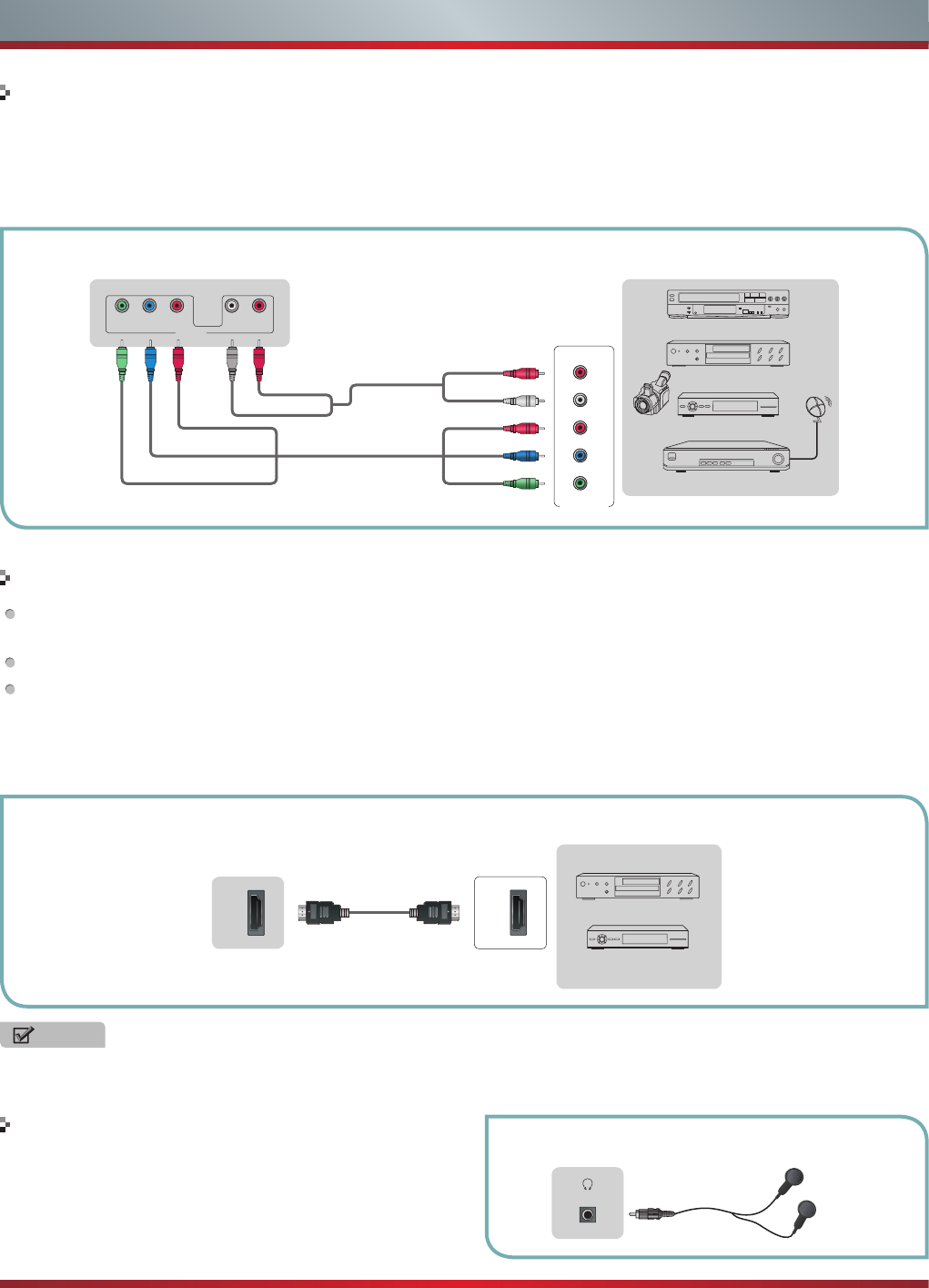
11
Getting Started
Connecting an A/V Device with Component (YPBPR) Cable
Connecting an A/V Device with HDMI Cable
Connecting a headphone
1. Use a component cable to connect the external A/V device’s component output jacks to the TV’s YPBPR jacks. Use an audio
cable to connect the external A/V device’s component audio jacks to the TV’s AUDIO (L/R) jacks.
2. Plug the connected devices into the mains socket before switching on the TV.
3. Select the corresponding source from the TV.
Support digital connections between HDMI - enabled AV devices such as PVR, DVD, Blu-Ray, AV receiver and digital
devices.
Some devices such as PVR or DVD player require HDMI signal to be set to output in the device's settings.
Please consult your device user manual for instructions.
1. Use an HDMI cable to connect the A/V device’s HDMI output jack to the TV’s HDMI jack.
2. Plug the connected devices into the mains socket before switching on the TV .
3. Select the corresponding source from the TV.
Headphones or an analog sound bar can be connected to
the HEADPHONE output on your set. (While the headphone
is connected, the sound from the built-in speakers will be
disabled.)
Y PBPR
COMP
L R
Equipment with A/V jacks
DVD Player/Recorder
Video
Camera
EXTERNAL DEVICES
Set-top box
Satellite Receiver
Satellite
antenna
cable
VCR
White(L)
White(L)
Red(R)
Red(R) Audio Cable
(not included)
Component Cable
(not included)
TV JACK
Component
R
L
PR
PB
Y
PR/CR
PR
PB/CB
PB
YY
HDMI
HDMI
TV JACK
EXTERNAL DEVICES
DVD
Set-top Box
HEADPHONE
EXTERNAL DEVICESTV JACK
NOTE
The HDMI connector provides both video and audio signals, it’s not necessary to connect an audio cable.
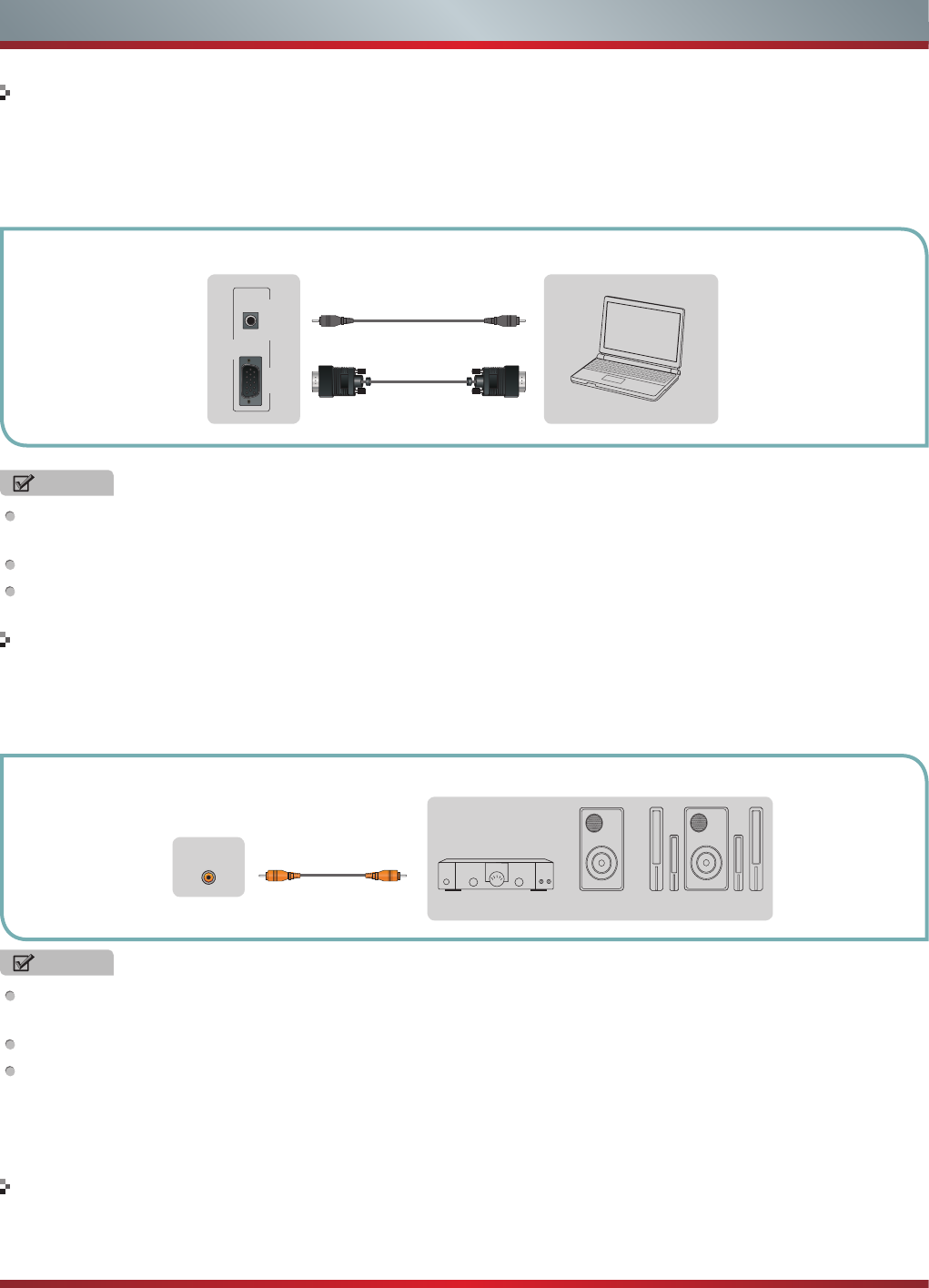
12
Getting Started
Connecting a PC with VGA Cable
Connecting an Audio Receiver with Digital Audio out cable
1. Use a VGA cable to connect the PC’s VGA output jack to the TV’s VGA jack. Use an audio cable to connect the PC’s audio
output jack to TV’s PC/DVI AUDIO IN jack.
2. Plug the connected devices into the mains socket before switching on the TV.
3. Select the corresponding source from the TV.
1. Use a coaxial cable to connect the A/V device’s digital audio in jack to the TV’s DIGITAL AUDIO OUT jack.
2. Plug the connected devices into the mains socket before switching on the TV.
3. Select the corresponding source from the TV.
NOTES
Primarily this unit is intended for use as an LCD TV. If you want to use it as a monitor, please contact the manufacturer of the
PC Video/Graphic's card for further support. Perfect compatibility is not guaranteed.
The VGA cable will not supplied with the product.
We strongly recommend to use VGA cable with 2 ferrite cores as shown in the figure.
NOTES
When a digital audio system is connected to the DIGITAL AUDIO OUT (COAXIAL) jack, decrease the volume of both the TV
and the system.
5.1 CH (channel) audio is available when the TV is connected to an external device supporting 5.1 CH.
When the receiver (home theater) is set to on, you can hear sound output from the TV’s digital audio out jack. When the TV
is receiving a DTV signal, the TV will send 5.1 CH sound to the home theater receiver. When the source is connected to the
TV via HDMI, only 2 CH audio will be heard from the home theater receiver. If you want to hear 5.1 CH audio, connect the
digital audio out jack from your DVD/Blu-ray player/cable box/STB satellite receiver directly to an amplifier or home theater.
TV JACKS
EXTERNAL DEVICES
Powerless
Bass Speaker
Speaker
Audio Amplier
DIGITAL
AUDIO OUT
Connecting an ethernet cable to access a network or the Internet
Connect an ethernet cable to access a network or the Internet. TV also features wireless connectivity. For more information,
see “Network Connection”.
EXTERNAL DEVICES
Computer
TV JACK
VGA
PC
PC/DVI
AUDIO IN
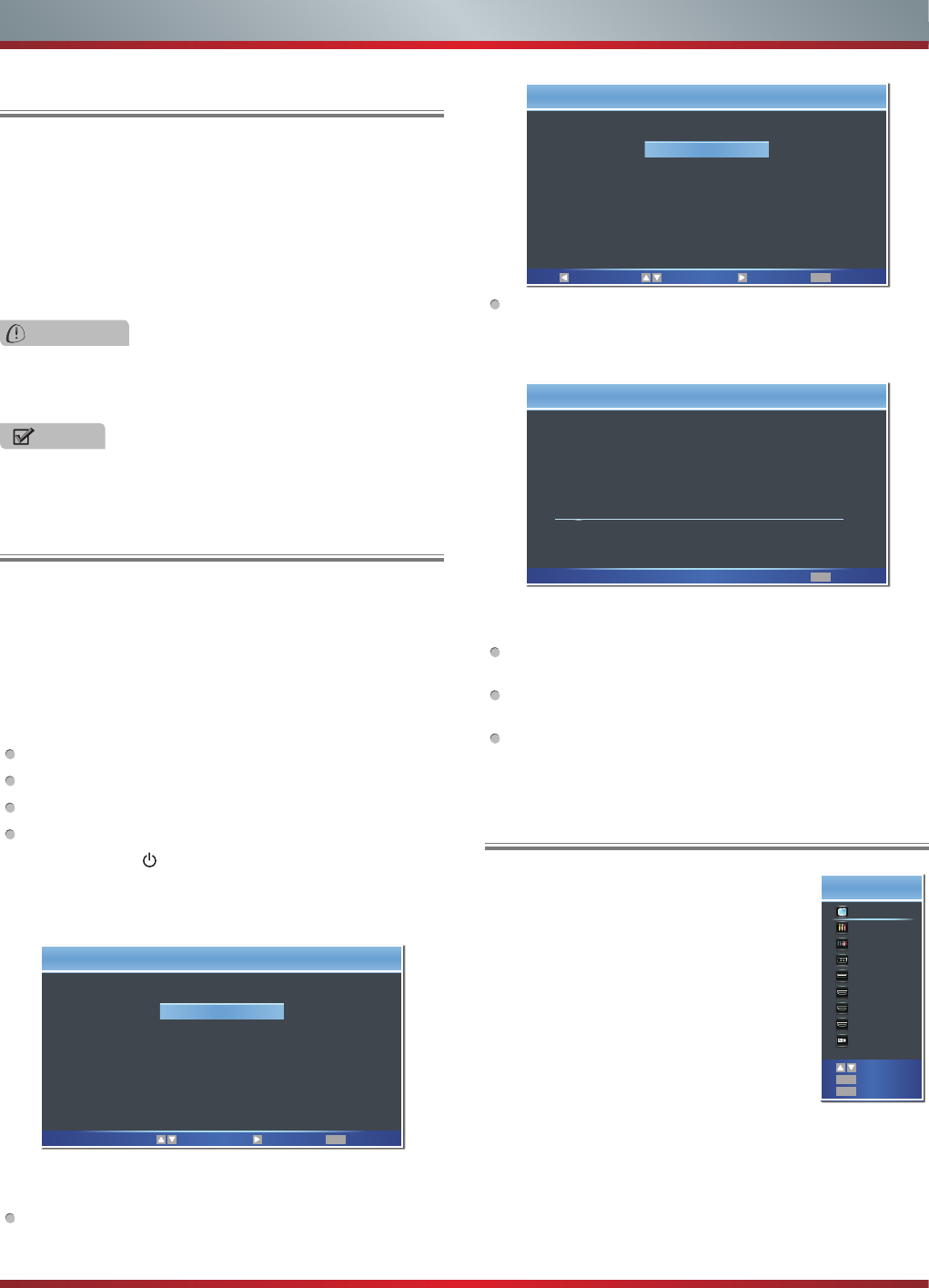
13
Basic Features
1. Make sure that you have:
Installed the remote control batteries.
Connected an antenna or cable.
Connected the power cord.
Matched the remote control with TV.
2. Press [POWER ] button to turn on your TV. The Setup
Wizard menu displays.
3. Press [▲/
▲
/
▲
/
▲
] to select your menu language: English,
Spanish or French, press [ENTER] button to confirm.
4. Press [▲/
▲
] to select your Picture Mode: Home Mode or
Retail Mode, press [ENTER] button to confirm.
If you select Retail Mode, a message appears “Are you
sure you want retail mode?” Select “Yes” to continue, or
select “No” to change your selection.
IMPORTANT: At first, you have to match the remote
control with TV.
To turn your TV on or off (standby mode):
1. Plug the power cord into an AC power outlet.
2. Press [POWER] button or use the Tap Pad located on the
TV (see “viewing the control panel”). Your TV turns on.
3. Press [POWER] button again to turn off your TV. When
you turn off your TV, it goes into standby mode.
The Setup Wizard menu appears the first time you turn
on the TV. It will assist you to specify the menu language,
Picture Mode, Tuner Mode and Channel Installation.
IMPORTANT: Make sure that the antenna or cable is
connected and a wired or wireless Internet connection is
available.
Turning the TV On for the First Time
Turning the TV on or off
If you selected Retail Mode, Energy Saving is not
realized.
5. Press [▲/
▲
] to select your Tuner Mode: Antenna or
Cable, press [ENTER] button to confirm.
6. Press [▲/
▲
] to set the Channel Installation: Scan or Skip
Scan, press [ENTER] button to confirm.
If you select “Scan”, your TV automatically starts Channel
Installation available in your viewing area.
If you select “Skip Scan”, your TV does not scan for
channels.
Depending on the reception condition, it may take up to
25 minutes or more to complete memorizing channels.
Please allow the process to complete without interruption.
WARNING
When your TV is in standby mode, it is still receiving
power. To completely disconnect power, unplug the power
cord.
NOTE
If your TV does not receive an input signal for several
minutes, it automatically goes into standby mode.
EXIT
Choose your menu Language
English
Español
Français
Select Next Exit
Back Select Next Exit
EXIT
Choose your Picture Mode
Home mode
Retail mode
EXIT
Please connect cable or antenna
Channel Installation
Status: Scanning...
ATV Program Installed: 3
DTV Program Installed: 2
Cancel
8%
The first time you turn on your TV, you
must select the TV signal source. Your
TV stores this information, so you do not
need to change the TV signal source
unless it changes. For example, you
change from an outside antenna to cable
TV.
To select the video input source:
1. Turn on your TV, then press [INPUT]
button on the remote or on the TV. The
Input Source menu opens.
2. Press [▲/
▲
] button to highlight the
input source, then press [ENTER]
button.
3. Press [POWER] button again to turn off your TV. When
you turn off your TV, it goes into standby mode.
Selecting the Input Source
INPUT
TV
AV
Component
VGA
HDMI 1
HDMI 2
HDMI 3
HDMI 4
Hi-DMP
EXIT
OK
Select
Enter
Exit
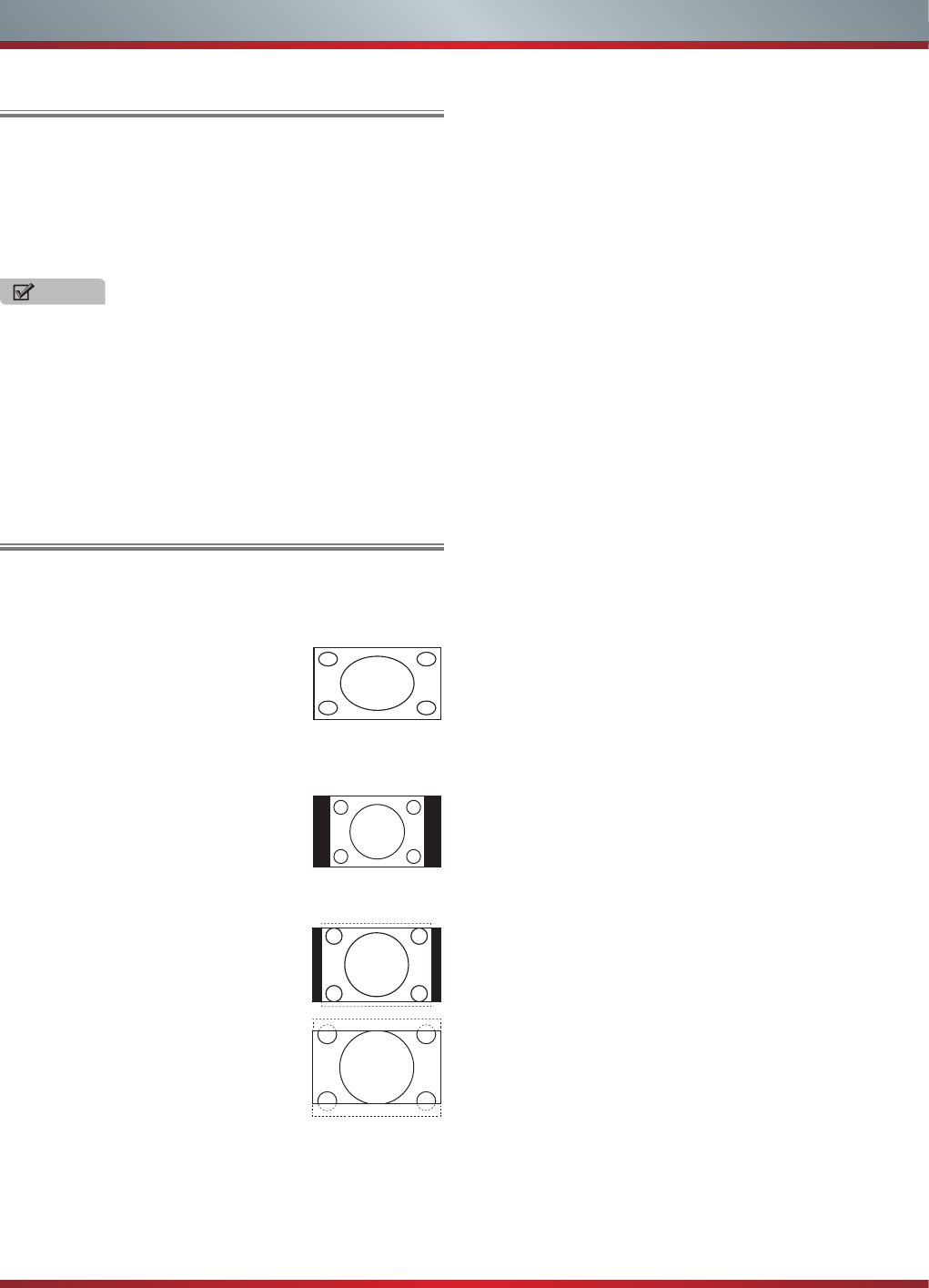
14
Basic Features
Aspect - Select the screen aspect ratio from Normal, Wide,
Zoom and Cinema.
Normal: The original 4:3 aspect
ratio (1.33:1 signal) is preserved,
so black bars are added to the left
and right of the image. Standard TV
broadcasts are displayed with a 4:3
aspect ratio.
Wide: When watching a standard
broadcast or full-frame movie in
this mode, the display image is
stretched proportionately to fill
the TV screen. When watching a
widescreen (1.78:1 signal) program
or movie, the display image fills the
TV screen.
Zoom: Stretch the 4:3 aspect ratio
image vertically and horizontally to
fill the screen at 1:1.78 aspect ratio.
Cinema: Stretch the 4:3 aspect ratio
image vertically and horizontally to
fill the screen at 1:2.35 aspect ratio.
Shortcuts Instructions
DISPLAY - Display the information banner. The information
including channel number, channel name, current system
time, tuner mode, audio stream, video format, audio
language, closed caption mode, parental locks rated,
program details, etc.
GUIDE - Open the DTV program guide. The program guide
information is provided by the broadcasting company.
FAV - Display your Favorite List. You can add or delete
channels to create your favorite list.
Cursor up/down: Press [▲/
▲
] button to select the
option.
Add/Erase: Press [YELLOW] button to add or delete the
channel from Favorite List.
Page up/down: Press [RED/GREEN] button to page up
or down.
VUDU - VUDUTM is an on-demand, pay-per-view, service
that offers high-definition movies via the Web. You can
access the VUDU service by pressing this button.
Hi-Smart - Press to open the Hi-Smart Hub. The Hi-Smart
Hub provides convenient access to Services and Apps
which let you watch movies, TV shows, listen to music, and
much more.
NETFLIX - Press to open the Netflix interface. Netflix is an
online DVD and Blu-ray Disc rental service, offering instant
access to movies and TV shows to Netflix members. Netflix
unlimited membership required (subscription not included).
1. Press the [CH
V
/V] (or [CH +/-]) on the TV/remote control
to change the channel.
2. Press the [VOL
V
/V] (or [VOL +/-]) on the TV/remote
control to adjust the volume.
3. Press the numeric buttons on the remote control to
display the corresponding channels.
Changing Channels / Volume
NOTE
Changing the channels can also be achieved by directly
entering the channel number using the numeric keys on
the remote control. If you are entering a two or three digit
channel number, the time between key presses should be
less than 3 seconds.
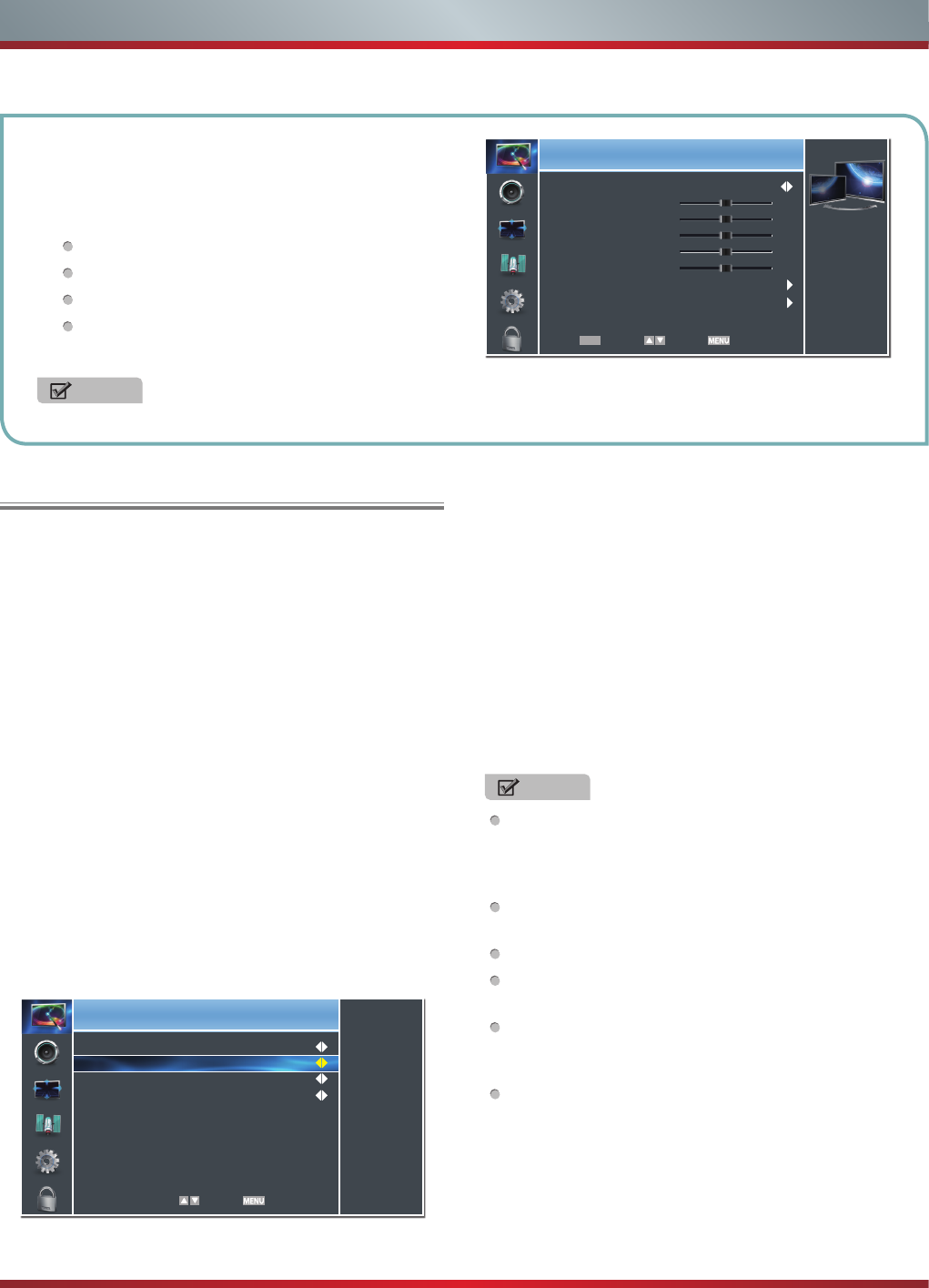
15
Basic Features
To Use the Menu
1Press the [Menu] button to open the main menu.
2Press [▲/
▲
] to select a menu option, then press
[
▲
/ENTER] to enter the menu.
3In each menu, you can:
Press [▲/
▲
] to select an item,
Press [
▲
/
▲
] to adjust the value, or
Press [
▲
/ENTER] to enter the submenu,
Press [RETURN] to exit the submenu.
4Press [EXIT] button to exit the menu.
NOTE
FOR ILLUSTRATION ONLY.
Using the Picture Menu
You can adjust:
Picture Mode - Adjust the Picture Mode. You can select
Standard, Theater, Energy Saving, Game, Custom or Vivid.
Brightness - Increase or decrease the brightness of the
picture. Increasing the brightness can add more light to dark
areas of the picture, while decreasing the brightness can
add more darkness to light areas of the picture.
Contrast - Increase or decrease the contrast of the picture.
Increase the contrast to adjust the white areas of the picture
or decrease the contrast to adjust the black areas of the
picture.
Color - Adjust the level of color in the picture.
Tint - Adjust flesh tones so they appear natural.
Sharpness - You can increase the sharpness level for
clearer images or decrease the sharpness level for smoother
images.
Advanced Video - Access advanced video settings such as
Color Temperature, Noise Reduction, Adaptive Contrast and
120Hz Smooth Effect.
Color Temperature: Change the color temperature. You
can select a preset color temperature: Cool, Standard
and Warm.
Noise Reduction: Optimize the picture quality by filtering
signal interference. You can select Off, Low, Medium or
High.
Adaptive Contrast: Automatically adjusts the contrast
level of the selected input source.
120Hz Smooth Effect: Inserts frames to reduce judder
in fast action scenes. You can select Off, Low, Middle or
High.
Picture
Select Back
Adjust advanced video
features DNR.
Color Temperature
Noise Reduction
Adaptive Contrast
120Hz Smooth Effect
Standard
Medium
Off
Off
NOTE
When 3D video is watched under the fluorescent lamp
(50~60 Hz) or tri-band fluorescent tube, there may be
slight flicker, so please adjust the illumination downward
or switch off the light.
Certain functions, such as Zoom, are not available when
watching 3D movies and TV shows.
Other brands 3D glasses may not be supported.
Sit upright facing the TV when watching 3D movies and
TV shows.
This TV supports automatic identification of common
3D formats when connected to HDMI V1.4 compatible
sources. Other 3D sources require manual setup.
Two pair of 3D glasses are included with your TV. To
obtain additional pairs of Hisense 3D glasses, please
contact customer service at 1-800-935-8880 for details
and purchase.
Enter Select Exit
Picture
Adjust image to suit
personal preferences.
Picture Mode
Brightness
Contrast
Color
Tint
Sharpness
Advanced Video
3D
50
50
50
0
10
StandardStandard
OK
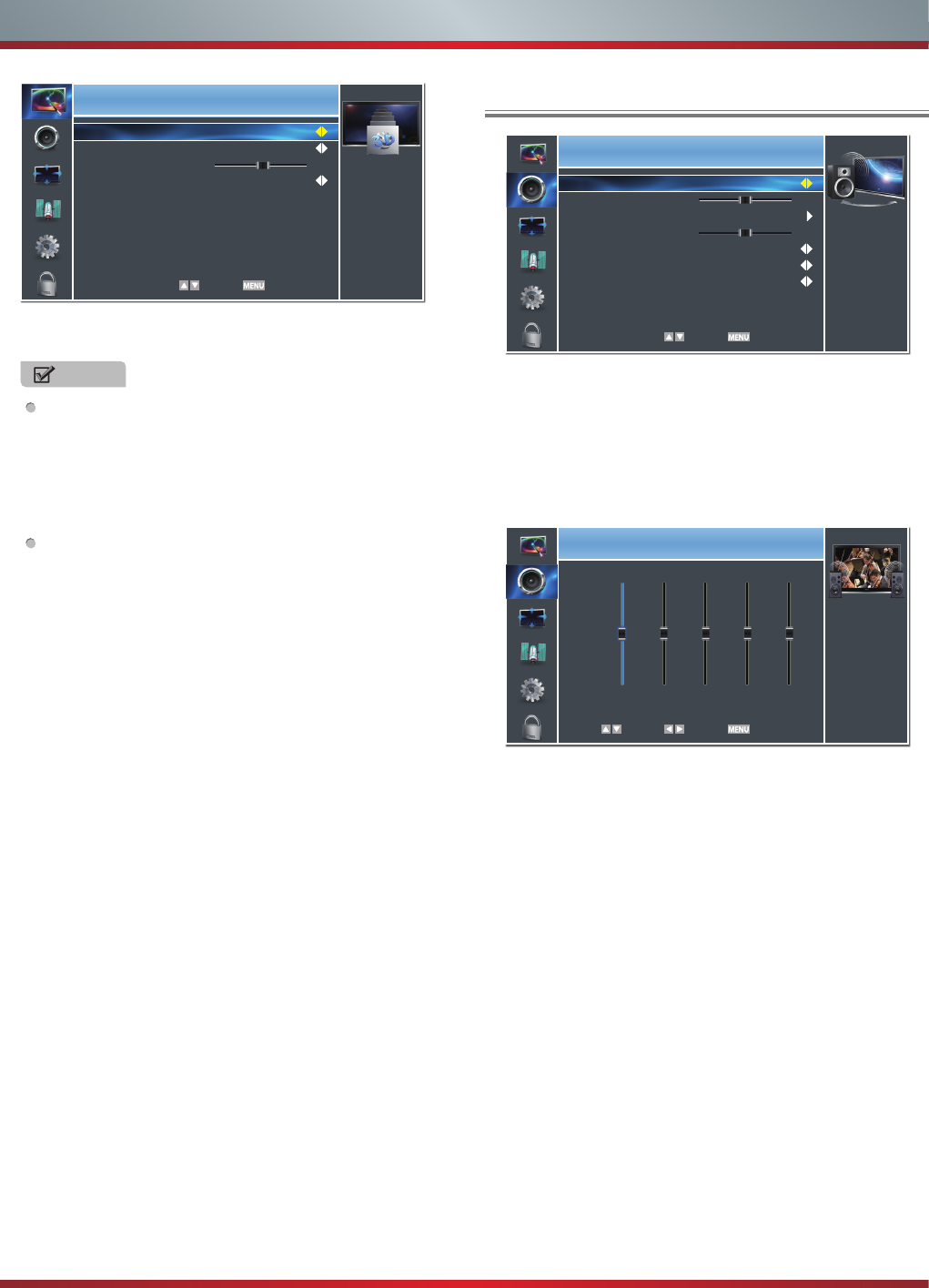
16
Basic Features
3D - Enables playback of 3D movies and TV shows (requires
compatible 3D glasses).
3D Mode: Format may be set to: Off, 2D-to-3D, Side-by-
Side or Top-and-Bottom.
L-R Switch: Flips the left and right frames in Side-by-
Side format.
Depth of Field: Adjusts the range of distance (focus) that
appears acceptably sharp in a 3D image.
3D-to-2D: Disables automatic identification of 3D format
during playback; forces 2D playback using only the Left
or Right frame.
Picture
Select Back
3D Mode.
3D Mode
L-R Switch
Depth of Field
3D-to-2D
Side-by-Side
LR
Off
16
NOTE
When 3D signal format is Frame Packing, the image
will be displayed according to the resolution of the
incoming signal.
For example: when the input signal is 1280×720, a
720p image will be displayed. A 1920×1080 input
signal will be displayed in 1080p.
When 3D signal format is Side-by-Side, Top-and-
Bottom, the image is displayed full screen in half
resolution (960× 1080 or 1920×540 respectively).
Using the Audio Menu
You can adjust:
Sound Mode - Select the Sound Mode: Standard, Speech,
User or Music.
Balance - Adjust the volume of the left and right speakers.
Equalizer - Soften or enhance the sound at specific
frequency points.
Bass Boost - Adjust the bass performance.
Sound Surround - Simulates surround sound and enhances
bass response.
Digital Audio Output - Send digital audio to an external
audio system. You can select PCM, RAW or Off.
PCM: PCM outputs two channel audio regardless of the
input format.
RAW: Passes through (output = input) the incoming audio
signal without decoding. E.g. incoming Dolby Digital, DTS
or PCM data stream is simply output as it is without any
processing.
Auto Volume Control - Automatically adjusts volume to a
consistent level; attenuates loud passages.
Audio
Select Back
Standard
Off
PCM
Off
0
0Select a Sound mode
to achieve ideal sound.
Sound Mode
Balance
Equalizer
Bass Boost
Sound Surround
Digital Audio Output
Auto Volume Control
Audio
Adjust Select Back
10DB
0DB
-10DB
0
120Hz
0
500Hz
0
1.5KHz
0
5KHz
0
10KHz
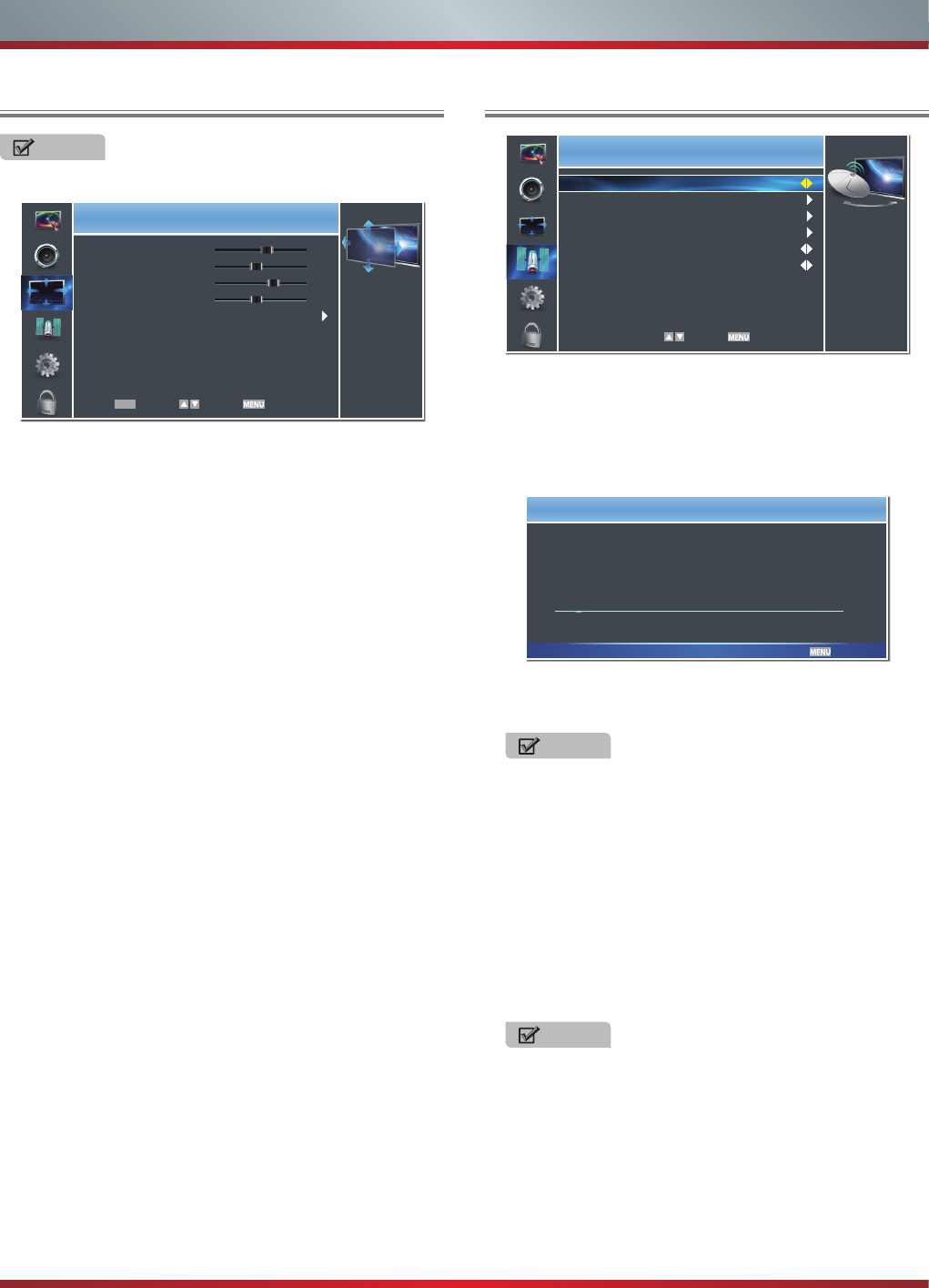
17
Basic Features
Using the Screen Menu Using the Channels Menu
You can adjust:
H.Position - Move the image right or left.
V.Position - Move the image up or down.
Phase - Adjust the focus of stable images.
Clock - Adjust the sample frequency.
Auto Adjust - Detects input signal clock, phase and position
and adjusts TV display accordingly.
You can adjust:
Tuner Mode - Select TV source: Antenna or Cable.
Auto Channels Search - Scans for channels that have
signals and stores the channels information in the channel
list.
Channel Skip - You can cancel a channel stored in the
channel list.
Favorite List - Add or delete channels to create a favorite
list. You can press [FAV] button to display your Favorite List.
MTS - Select the default audio stream: Mono, Stereo or
SAP.
Audio Language - Select the audio language: English,
Español or Français.
NOTE
Only available in VGA mode.
Screen
Enter Select Exit
39
30
23
127 Image positioning
and PC settings.
H.Position
V.Position
Phase
Clock
Auto Adjust
OK
Channels
Select Back
Select tuner connect
mode.
Tuner Mode
Auto Channel Search
Channel Skip
Favorite List
MTS
Audio Language
Antenna
Stereo
English
Cancel
Auto Scan
Status: Scanning... Antenna
Analog Channels: 0
Digital Channels: 0
8%
NOTE
When you press [CH
V
/ V] button, your TV skips
the channel you cancelled. You can still tune to the
channel using the number buttons on the remote
control.
NOTE
Only available in TV mode.
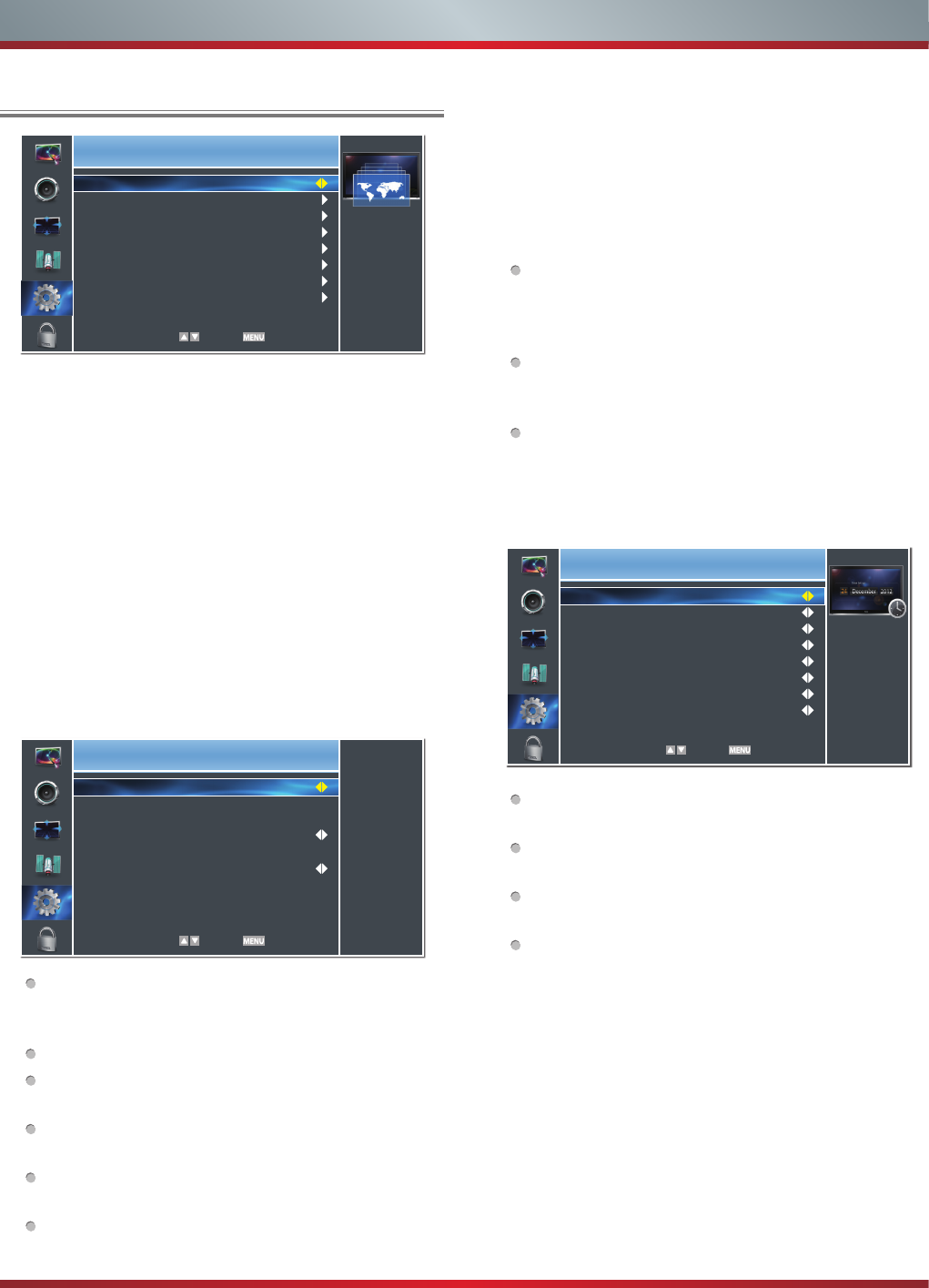
18
Sleep Timer: Specify the amount of time before your TV
automatically turns off: Off -10-...-120 minutes.
Caption - Adjust Closed Captioning settings.
Caption Control: Select the Closed Caption mode: CC
Off, CC On or CC On When Mute.
Analog Closed Caption: Select an Analog Caption
setting:
CC1~CC4: Closed captioning appears in a small
banner across the bottom of the screen. CC1 is usually
the “printed” version of the audio. CC2~CC4 display
content are provided by the broadcaster.
Text1~Text4: Closed captioning that covers half or
all of the screen. Text1~Text4 display content are
provided by the broadcaster.
Off: To turn off the Analog Caption.
Digital Closed Caption: Select a Digital Caption setting:
Service1~Service6 or Off.
Digital Caption Style: Customize the look of digital
Closed Captioning.
Caption Style: Set the look of Digital CC. “As
Broadcaster” uses broadcaster’s style.
Font Size/Style/Color/Opacity: Select the size/style/
color/opacity level of font.
Background Color/Opacity: Select the color/opacity
level of the background.
Window Color: Select the color of the window.
Network - You can setup the network configuration in this
menu. For more information, see “Network Connection” and
“Network Setup”.
Demo Mode - Displays a banner at the bottom of the screen
which describes the key features of the TV.
Version Info - Display the software version information.
You may need to reference this information when contacting
Customer Care or upgrading the firmware online.
Reset Default - Restores the TV configuration to factory
settings. You will need to complete the setup for such things
as Tuner/Channel settings, Network connection, Date/Time
and other user preferences.
Basic Features
Settings
Select Back
Clock, date and timers
settings.
Caption Style
Font Size
Font Style
Font Color
Font Opacity
Background Color
Background Opacity
Window Color
Custom
Large
Style 1
White
Solid
Black
Solid
Black
Using the Settings Menu
You can adjust:
Language - You can select the menu’s language to English,
Español or Français.
Menu Settings - You can set On-screen menu system.
Timeout: Select the display time of the menu: 10-20-...-
60 seconds.
Time Setup - Set the time zone, daylight saving, time and
sleep timer.
Time Zone: Select your local time zone: Eastern Time,
Indiana, Central Time, Mountain Time, Arizona, Pacific
Time, Alaska or Hawaii.
Daylight Saving: Set the Daylight Saving time for your
area.
Time: You can set time manually or select automatic if
the TV is connected to an antenna or cable source.
Auto Synchronization: Select “On” for automatic
date and time setting using information from broadcast
stations in your area.
Date/Time: Set the current year/month/day/time.
Power On Timer: When “On”, you can set the time
when the TV turns on automatically.
Time: Set the desired time for the TV to turn on
automatically.
Power Off Timer: When “On”, you can set the time
when the TV turns off automatically.
Time: Set the desired time for the TV to turn off
automatically.
Settings
Select Back
Adjust OSD language.
Language
Menu Settings
Time Setup
Caption
Network
Demo Mode
Version Info
Reset Default
English
Settings
Select Back
Obtain date and time
from broadcaster.
Auto Synchronization
Date
Time
Power On Timer
Time
Power Off Time
Time
On
2012/01/01
01:01 PM
Off
12:00 AM
Off
12:00 AM
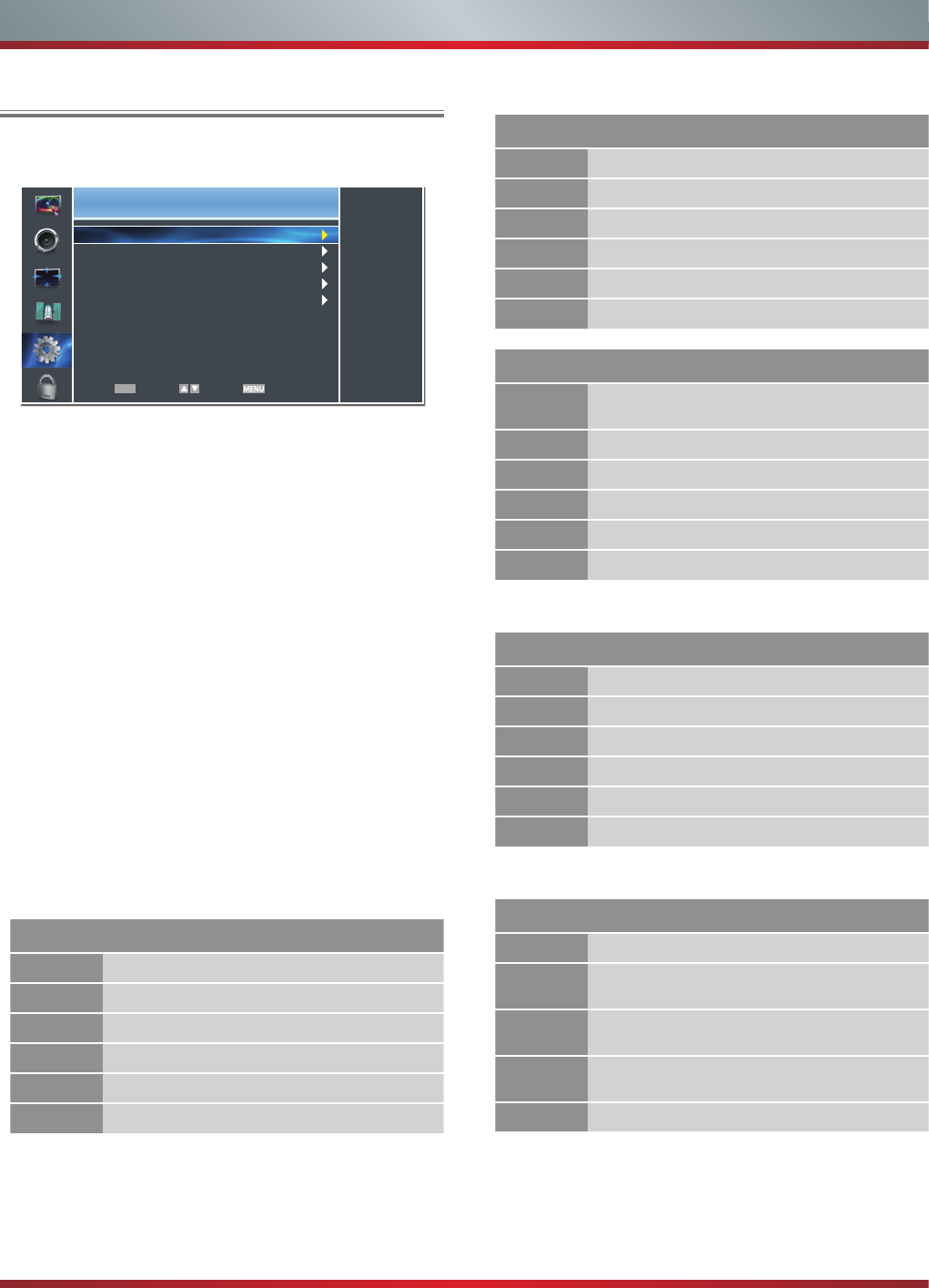
19
Basic Features
Using the Lock Menu
When you first use this function, the default password is
[0000]. Once you input this password, you can set options.
You can adjust:
Channel Block - Block selected Channels on the TV.
Program Block - Block selected Programs on the TV.
Rating Enable: Block or unblock TV ratings.
U.S. TV Ratings: Restrict TV programs by USA Ratings.
U.S. Movie Ratings: Restrict movie by USA Ratings.
Canadian English/French Ratings: Restrict movie and
TV programs by Canadian Ratings.
Open V-Chip: Display an advanced V-Chip ratings table
for digital channels (USA only).
Block Unrated: Block unrated TV programs.
Input Block - Block selected Input source on the TV.
Change Password - If you want to change the default
password, first enter the new password then enter the same
password again.
Clean All - You can reset all locks to factory mode.
Following is the description of these ratings.
U.S. Movie Ratings
Rating Defined as
G General audience
PG Parental Guidance suggested
PG-13 Parents strongly cautioned
R Restricted
NC-17 No one 17 and under admitted
X Adult audience only
Lock
Enter Select Back
Prevent access to TV
services.
Channel Block
Program Block
Input Block
Change Password
Clean All
OK
U.S. TV Ratings
Age Defined as
TV-Y All children
TV-Y7 Directed to older children
TV-G General audience
TV-PG Parental Guidance suggested
TV-14 Parents Strongly cautioned
TV-MA Mature Audience only
Contents Defined as
AAll of the ratings below that rating set blocked
automatically
D Suggestive dialogue
L Strong language
S Sexual situations
V Violence
FV Fantasy Violence
Canadian English Ratings
Rating Description
C Children
C8+ Children 8 years and older
GGeneral Programming, suitable for all audiences
PG Parents Guidance
14+ Viewers 14 years and older
18+ Adult Programming
Canadian French Ratings
Rating Description
G General
8 ans+ 8+General; Not recommended for young
children
13 ans+ Programming may not be suitable for children
under the age of 13
16 ans+ Programming is not be suitable for children
under the age of 16
18 ans+ Programming restricted to adults
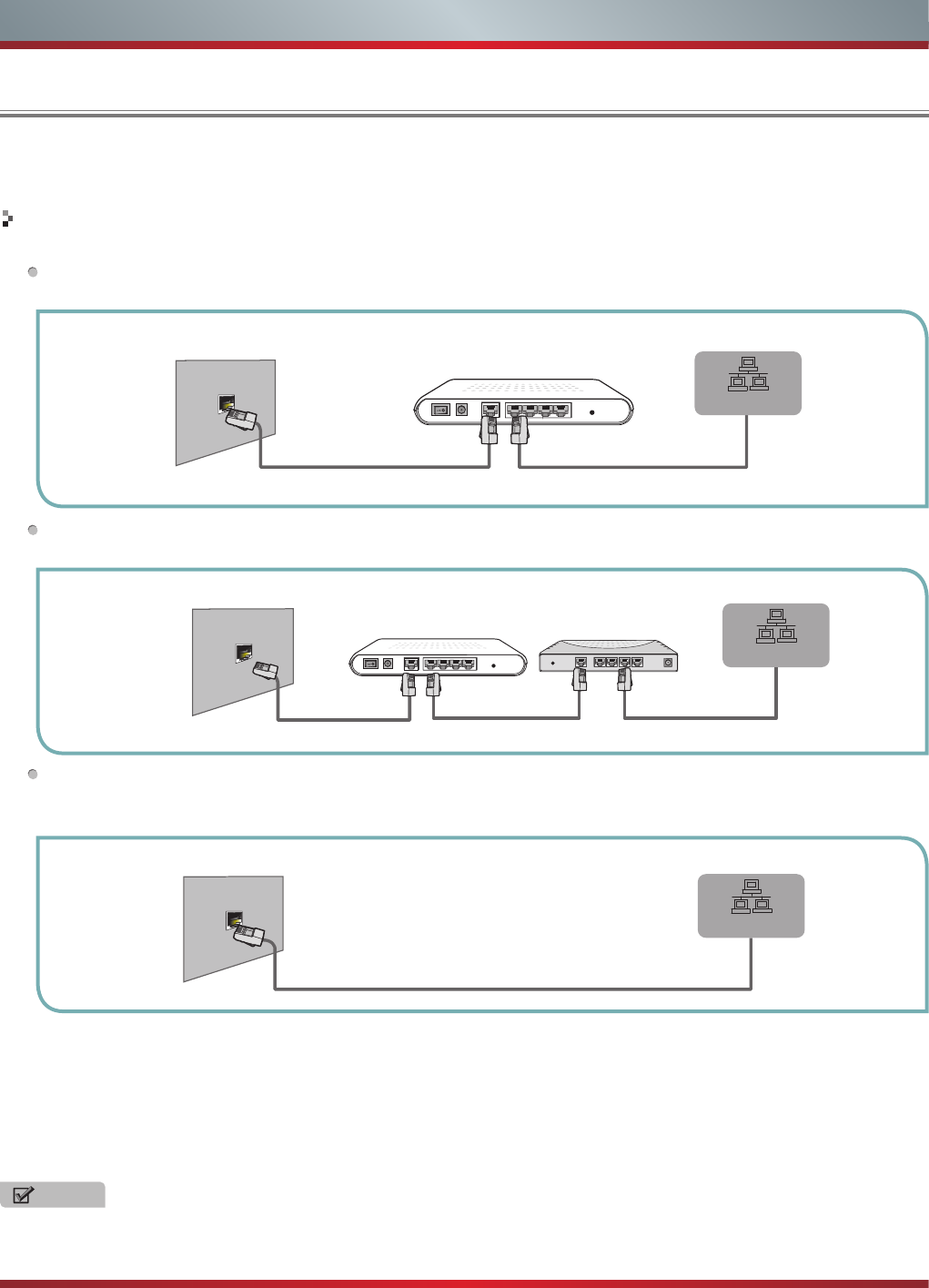
20
Advanced Features
Network Connection
You can set up your TV so that it can access the Internet through your local area network (LAN) with a Ethernet or wireless
connection.
Connecting to a Wired Network
You can attach your TV to your LAN by one of the three following ways:
You can attach your TV to your LAN by connecting the LAN port on the back of your TV to an external modem using a Cat
5 LAN cable. See the diagram below.
You can attach your TV to your LAN by connecting the LAN port on the back of your TV to an IP Sharer which is
connected to an external modem. Use LAN cable for the connection. See the diagram below.
Depending on how your network is configured, you may be able to attach your TV to your LAN by connecting the LAN
port on the back of your TV directly to a network wall outlet with a Cat 5 cable. See the diagram below. Note that the wall
outlet is attached to a modem or router elsewhere in your house.
If you have a Dynamic Network, you should use an ADSL modem or router that supports Dynamic Host Configuration
Protocol (DHCP). Modems and routers that support DHCP automatically provide the IP address, subnet mask, gateway,
and DNS, so you don’t have to enter them manually. Most home networks are Dynamic Networks.
Some networks require a Static IP address. If your network requires a Static IP address, you must enter the IP address,
subnet mask, gateway, and DNS values manually on your TV’s Cable Setup Screen when you set up the network
connection. To get the IP address, subnet mask, gateway, and DNS values, contact your Internet Service Provider (ISP).
If you have a Windows computer, you can also get these values through your computer.
The Modem Port on the Wall
Modem Cable LAN Cable
LAN Port on TV
External Modem
(ADSL / VDSL / Cable TV)
LAN
The Modem Port on the Wall
Modem Cable LAN Cable LAN Cable
LAN Port on TV
External Modem
(ADSL / VDSL / Cable TV)
IP Sharer (Router)
(with DHCP server)
LAN
The LAN Port on the Wall LAN Port on TV
LAN Cable
LAN
NOTE
You can use ADSL modems that support DHCP if your network requires a Static IP address. ADSL modems that support
DHCP also let you use Static IP addresses.